

bringing faith into the home
march 2024 | catholic spirituality
193rd year | issue 3
MAGAZINE
“Our employees are what make RetireMed so special. We’re a family.” – Kevin Lowden
is a Senior Account Manager at RetireMed and a parishioner

dedicated employees set us apart.
Helping you choose a Medicare plan or health coverage before Medicare is only the beginning. Our team of local Client Advisors can assist you all year long!
We’re happy to explain your coverage and benefits, check to see if providers are in-network, and guide you in setting up mail order prescriptions to save time and money. We’ll even help you navigate and resolve billing or claim issues.
No matter what comes up, we’ll be with you every step of the way.
2 | Call 866.625.4609 | retiremed.com/tct
Our
Kevin Lowden, pictured below with his family,
at St. Albert the Great in Kettering.
Seeking God Amid Life’s Trials
As I write this article, I’m surrounded by children with the flu. Coughing, fever, body aches and calls for more Tylenol and water have been part of our hourly routine for the past five days. Even now, I’m fighting off the inevitable congestion and body aches and know my time with the virus is inevitable. Amidst the suffering, it’s easy to fall into a “why me” mentality, to focus on the tears and fevers around me and think of nothing else. And sliding into that mental loop of negativity only makes everything worse.
Times like these help me look at others who suffered far worse than me and come out on the other side for the better. One of the neatest things about our faith is that no matter how much we read, study and learn there is always more to discover. This month’s issue on Catholic spirituality certainly opened the door for me to do a deep dive on prayer traditions I was less familiar with—ones that tap into saints who endured tremendous suffering.
While editing Father Jacob Boddicker’s article on Ignatian Spirituality—a tradition with which I am familiar but don’t often turn to—I was reminded that in the midst of being bedridden, injured and bored to tears, St. Ignatius turned to the lives of Christ and the saints and to his own interior movements. And while I’m certainly not in a place in life where I can forsake my family and dwell in a cave for contemplation, I can make time to walk through the steps that Father Jacob shares in his article (pg. 27). In particular: “Ask God to enlighten your mind, heart and soul to better notice and understand how He has been at work in your life.”
In fact, all the steps Father Jacob listed for contemplation are very similar to those I learned through traditional therapy
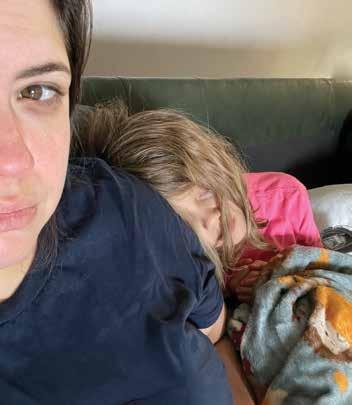
over the years for managing anxiety and depression—but these incorporate God and promote a greater sense of gratitude and optimism.
And so, as I continue to navigate this time of seemingly relentless illness in our home, I will reflect on Father Jacob and St. Ignatius’ advice, especially when I feel overwhelmed:
“Where did you experience God’s presence and love; how did you respond? Where did you experience His absence, distance; where did you move away from Him? Ask His forgiveness for any moments of sin.”
My hope is that instead of feeling sad and overwhelmed by all the illness that winter brings, I may instead find God’s love in these moments I get to experience at home with my children.
I hope that the wealth of wisdom on Catholic spirituality contained in this issue of The Catholic Telegraph may also inspire you to dig deeper into your faith and find God in the everyday, sometimes tedious, moments of your life.

cteditorial@catholicaoc.org
PUBLISHER
Archbishop Dennis M. Schnurr
MEDIA SALES
Deacon Graham Galloway
NEW MEDIA EDITOR
Greg Hartman
EDITORIAL DIRECTOR
Jessica Rinaudo
GRAPHIC DESIGN
Emma Cassani
DIGITAL ENGAGEMENT
Trenton Scroggins
PHOTOGRAPHY
Margaret Swensen
SOCIAL MEDIA Taylor Motley
| 3 T HE CATHOLIC TELEGRAPH 193rd Year No. 3 • MARCH 2024 513-263-6635 • thecatholictelegraph.com 100 East Eighth St., Cincinnati, OH 45202 ctadvertising@catholicaoc.org The Catholic Telegraph (xUSPS 094-520) ISSN. 10736689 is published monthly by the Archdiocese of Cincinnati 100 E 8th St., Cincinnati, OH 45202. Periodicals postage paid at Cincinnati and at additional mailing office. POSTMASTER: Send address changes to: The Catholic Telegraph, 100 E. 8th St., Cincinnati, OH 45202
EDITOR’S NOTE
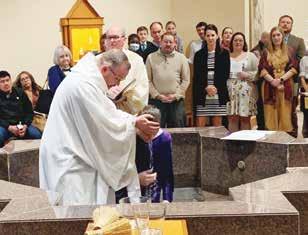
Tri-County Catholics page 8
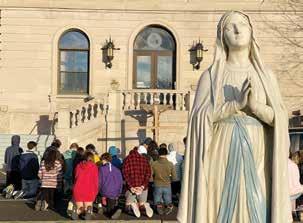
Spiritual Centers
Across the Archdiocese page 16
news
8 TRI-COUNTY CATHOLICS
BY LISA FLETCHER
Bringing parishes together through the Eucharist
12 A PLACE OF SUPPORT, A PLACE OF HOPE
BY RACHEL WEIDNER
14 SAVING SOLES
JOHN STEGEMAN
Footcare for the Souls offers practical care and dignity to the poor
33 ARCHDIOCESAN FISH FRY GUIDE
40 OUT & ABOUT IN THE ARCHDIOCESE
ON THE COVER
Marian Grotto at Our Lady of the Holy Spirit Center in Norwood, OH.

march contents
catholic spirituality columns
16 SPIRITUAL CENTERS
KARY ELLEN BERGER
20 SPIRITUAL DIRECTION
EILEEN CONNELLY, OSU
Walking your faith journey with accompaniment
23 CATHOLIC SPIRITUALITY A treasure trove of prayer
24 DOMINICAN SPIRITUALITY
FATHER JOHN LANGLOIS, OP
25 CARMELITE SPIRITUALITY
CYNTHIA MONTANARO
26 FRANCISCAN SPIRITUALITY
BROTHER MARK SOEHNER, OFM
27 IGNATIAN SPIRITUALITY
FATHER JACOB BODDICKER, SJ
28 ROOTED IN THE LANGUAGE OF THE SOUL MATT HESS
St. Joseph Protector of the Holy Family Carmelite Community
38 KIDS’ CORNER BY JESSICA RINAUDO
ILLUSTRATED BY EMMA CASSANI St. Benedict
7 QUESTION OF FAITH FATHER DAVID ENDRES
Age for receiving sacraments
10 A CLOSER LOOK
DR. KENNETH CRAYCRAFT
Groaning through Lent with St. Paul and Flannery O’Connor
19 CATHOLIC AT HOME
KATIE SCIBA
The particularity of holy simplicity
30 DID YOU KNOW?
BY GAIL FINKE
ILLUSTRATED BY EMMA CASSANI
St. Ann, Hamilton
31 BOOK REVIEW
FATHER AMBROSE DOBROZSI
Walk the Line: Rock Music and the Christian Imagination
32 ST. JOSEPH’S TOOL BELT TRENTON SCROGGINS
St. Joseph: why him?
36 THEOLOGY OF THE BODY
DR. ANDREW SODERGREN
The body and purity of heart
42 THE FINAL WORD
BELLE GRUBERT
Worship through adoration and music
POPE FRANCIS’ PRAYER INTENTION FOR MARCH
For New Martyrs
Let us pray that those who risk their lives for the Gospel in various parts of the world might imbue the Church with their courage and missionary drive.
4 | THE CATHOLIC TELEGRAPH

Seek the Lord
Catholics mark the beginning of the holy season of Lent with the reception of blessed ashes, acknowledging our sinfulness and the reality that one day we ourselves will return to dust. Over the course of these 40 days, the Church encourages us to refocus our lives on the things of heaven and to turn away from the things of this passing world. The spiritual disciplines which we practice with increased fervor during these weeks have an effect beyond this liturgical season. Our prayer, fasting and almsgiving are all directed toward the ongoing conversion of our hearts, so that we who seek pardon for our sins may one day share in the newness of life of the Risen Son of God.
Pope Benedict XVI spoke about the integral relationship between Lent and Easter, saying, “As she awaits the definitive encounter with her Spouse in the eternal Easter, the Church community, assiduous in prayer and charitable works, intensifies her journey in purifying the spirit, so as to draw more abundantly from the Mystery of Redemption the new life in Christ the Lord” (2011 Message for Lent). God is inviting us to prepare ourselves to share in the new life which flows from the Resurrection of His Son. Sin blocks our reception of that new life, which is why the Church especially calls us to the Sacrament of Penance and Reconciliation during Lent. Other spiritual practices can also dispose our souls to more effectively receive the graces which God desires to pour out upon us.
God knows and loves each of us personally, as unique individuals, and He knows which gifts of His grace each of
us needs in the particular circumstances of our lives. God does not encounter all of us in the same way, and not all of us experience God in the same way. For this reason, the Catechism of the Catholic Church states, “many and varied spiritualities have been developed throughout the history of the churches” (CCC 2684).
These spiritualities can be born from individuals’ experiences of God passed on through religious congregations or ecclesial movements. In this sense we refer to Dominican, Ignatian, Benedictine, Carmelite or Franciscan spiritualities. These also “arise at the point of convergence of liturgical and theological currents, bearing witness to the integration of the faith into a particular human environment and its history” (CCC 2684). Based on our own personalities, it is common to find the devotional prayers, practices and emphases of a particular spirituality to be an attractive or comfortable aid to our encounter with God. This is a beautiful manifestation of the diverse ways the Spirit acts in the Church. Such varied action of the Spirit reminds us of the great desire of God to draw every person back to Himself for all eternity.
We make that journey back to the God who created us together. We each have a unique relationship with God, and He gives each of us unique gifts that we can contribute to the whole Church’s journey back to fullness of life with God. May these weeks of Lent, leading us to the joy of Easter, be a time when our individual spiritual growth builds up the entire Body of Christ!
| 5
SEEK THE LORD / MARCH 2024
ARCHBISHOP DENNI S M. SCHNURR
Busca al Senor
ARZOBISPO DENNIS M. SCHNURR
Los católicos marcamos el comienzo del sagrado tiempo de Cuaresma con la recepción de las cenizas benditas, reconociendo nuestra pecaminosidad y la realidad de que un día nosotros mismos volveremos al polvo. A lo largo de estos 40 días, la Iglesia nos anima a volver a centrar nuestras vidas en las cosas del cielo y a alejarnos de las cosas de este mundo pasajero. Las disciplinas espirituales que practicamos con mayor fervor durante estas semanas tienen un efecto más allá de este tiempo litúrgico. Nuestra oración, ayuno y limosna están todos dirigidos a la conversión continua de nuestros corazones, para que nosotros, que buscamos el perdón de nuestros pecados, podamos algún día compartir la novedad de la vida del Hijo de Dios resucitado.
El Papa Benedicto XVI habló de la relación integral entre la Cuaresma y la Pascua, diciendo: “La Comunidad eclesial, asidua en la oración y en la caridad operosa, mientras mira hacia el encuentro definitivo con su Esposo en la Pascua eterna, intensifica su camino de purificación en el espíritu, para obtener con más abundancia del Misterio de la redención la vida nueva en Cristo Señor” (Mensaje de Cuaresma 2011). Dios nos invita a prepararnos para participar en la vida nueva que brota de la Resurrección de Su Hijo. El pecado bloquea nuestra recepción de esa nueva vida, por eso la Iglesia nos llama especialmente al Sacramento de la Penitencia y la Reconciliación durante la Cuaresma. Otras prácticas espirituales también pueden disponer nuestra alma para recibir más eficazmente las gracias que Dios desea derramar sobre nosotros.
Dios conoce y ama a cada uno de nosotros personalmente, como individuos únicos, y sabe cuáles dones de su gracia necesitamos cada uno de nosotros en las circunstancias
particulares de nuestras vidas. Dios no sale al encuentro de cada persona de la misma manera, y no todos experimentamos a Dios de la misma manera. Por esta razón, el Catecismo de la Iglesia Católica afirma: “se han desarrollado diversas espiritualidades a lo largo de la historia de la Iglesia” (CIC 2684).
Estas espiritualidades pueden nacer de las experiencias individuales de Dios transmitidas a través de congregaciones religiosas o movimientos eclesiales. En este sentido nos referimos a las espiritualidades dominicana, ignaciana, benedictina, carmelita o franciscana. Continúa el Catecismo diciendo: “En la confluencia de corrientes litúrgicas y teológicas se encuentra también una espiritualidad que muestra cómo el espíritu de oración incultura la fe en un ámbito humano y en su historia” (CIC 2684). Basados en nuestras propias personalidades, es común encontrar que las oraciones devocionales, las prácticas y los énfasis de una espiritualidad particular son una ayuda atractiva o cómoda para nuestro encuentro con Dios. Esta es una hermosa manifestación de las diversas formas en que actúa el Espíritu en la Iglesia. Una acción tan variada del Espíritu nos recuerda el gran deseo de Dios de atraer a cada persona hacia Él por toda la eternidad.
Realizamos juntos ese viaje de regreso al Dios que nos creó. Cada uno de nosotros tiene una relación única con Dios, y Él nos da a cada uno de nosotros dones únicos que podemos contribuir al camino de toda la Iglesia de regreso a la plenitud de vida con Dios. ¡Que estas semanas de Cuaresma, llevándonos a la alegría de la Pascua, sea un tiempo en el que nuestro crecimiento espiritual individual edifique todo el Cuerpo de Cristo!
6 |
THE CATHOLIC TELEGRAPH

QUESTION OF FAITH
Age for Receiving Sacraments
How is it decided what is the proper age for receiving Holy Communion and Confirmation? Why do some parishes offer the sacraments at different ages?
The age considered proper for sacramental reception has changed over time. In the early Church, the sacraments of initiation (Baptism, Confirmation and Holy Communion) were linked and the bishop often administered them to adult converts. As the number of Christians increased, bishops could not provide the sacraments of initiation to all who desired them. In the West, the tradition developed wherein Baptism was separated from Confirmation and Communion to preserve the bishop’s role in confirming candidates.
VARIED TRADITIONS
Over time, the age of sacramental reception varied, depending largely on geography. In the Eastern Catholic Church, the reception of Baptism, Confirmation and Holy Communion remained linked, and as such, are usually administered to infants. In the Western (Roman) Church, the three sacraments are customarily offered separately to children and adolescents, though together to adult converts.
By the early 20th century, in the Roman Catholic Church, both Holy Communion and Confirmation were delayed until adolescence. Until 1910, First Communion was delayed until age 14 and Confirmation was postponed until after Communion, allowing for a longer period of catechesis.
AGE OF REASON
In 1910, to promote more frequent reception of the Eucharist, Pope Pius X determined that First Communion should be linked to the “age of reason” (according to canon law, at age seven). At this age children are considered capable of understanding the chief mysteries of faith, including the sacraments, and can begin to distinguish between the Eucharist as the Body of Jesus and ordinary bread.
Though children are usually admitted to the sacraments as a group, parents, catechists and ministers can take into account
the individual readiness of each child, which could delay reception of the sacraments in certain cases.
ROLE OF THE BISHOP
Within the Church, dioceses (and even parishes) have different practices regarding the age of sacramental reception. In some, the sacraments are received according to the “restored order,” with Confirmation being received shortly before Communion, both at about age seven. Both orderings (Confirmation administered before and after First Communion) are acceptable, as determined by the local bishop.
Regardless of when the sacraments are received, they are to be administered after a period of preparation, which involves learning about the sacrament, its significance, and its accompanying responsibilities.
In the Archdiocese of Cincinnati, First Communion is received at the age of reason and Confirmation is administered after the reception of First Communion and between 12 and 16 years old. This timing emphasizes that Confirmation is a sealing of the gifts of the Holy Spirit and not a sacrament of reaching Christian maturity nor a “graduation” from religious education.
FOREVER LINKED
Whether received in infancy or later in life, the three sacraments of initiation provide the foundation for living the Christian life. Often received in stages, their reception “bears a certain likeness to the origin, development and nourishing of natural life” (Catechism of the Catholic Church, 1212).
The sacraments of initiation are instituted by Christ and forever linked. Through Baptism, the Christian is born anew; through Confirmation, strengthened; and in the Eucharist, nourished with the food of eternal life.

FATHER DAVID ENDRES
is professor of Church history and historical theology at Mount St. Mary’s Seminary & School of Theology.
| 7
QUESTION OF FAITH / MARCH 2024

{ tri-county catholics }
BRINGING PARISHES TOGETHER THROUGH THE
Eucharist
BY LISA FLETCHER
What better way to bring a Family of Parishes together than through the Eucharist, the source and summit of Catholic life?
That was the thought of Father Ed Burns and his staff at TriCounty Catholics Family of Parishes, which includes St. Gabriel and St. Michael churches in Cincinnati and St. John in West Chester.
When Beacons of Light prompted staffing changes in July of 2022, Tri-County Catholics tried something new and bold: They unified the three parishes in one RCIA program and held one combined Easter Vigil in 2023 at the largest of the churches, St. John, which also houses a large baptismal font for adult baptisms.
“On this holiest night of the year, we felt it was best for our parishes to come together as one,” Father Burns said.
Becky Albrinck, Director of Evangelization for Tri-County Catholics agreed. “This was the first ministry we did as a family,” she said. “RCIA candidates and catechumens often experience their own community as they learn and grow together, and we wanted them to enter the Church together as well.”
As they hoped, the group of RCIA candidates wasn’t the only community built. “This was a chance for us to combine resources for the Vigil,” Albrinck said. “Ministers were selected from all
three Churches, and the most exciting part was having choir members present from the entire Family.”
“A large choir, with multiple instrumentalists, led our people together in song and worship,” she continued.
The success of that first combined Easter Vigil in 2023, attended by more than 400 parishioners, means Tri-County Catholics is again preparing to bring their churches together for a very special evening.
It wasn’t easy in the beginning to convince all parishioners that this was a good idea. “It is hard, and in fact heartbreaking, when parishioners have attended the Vigil for years at their own churches, and then must go to another church,” Albrinck admitted. “The change was difficult.”
However, initial hesitations and worries eventually transformed into acceptance and appreciation. “The looks on their faces when they saw a greeter, choir members, music directors, Eucharistic ministers and more representing their smaller communities was just amazing,” Albrinck said. “It was the highlight of our first year together.”
was wonderful to have many parishioners from our three churches join in various ways. And with the lights down and everyone’s baptismal candle lit for the singing of the Exultet, it was just beautiful.”
Tri-County Catholics has tried to keep the Eucharist as their Family of Parishes’ central focus. According to Fr. Burns, “First and foremost, we make sure the weekly celebration of the Mass is done well.”
Ministers were selected from all three Churches, and the most exciting part was having choir members present from the entire Family.
In addition, Tri-County Catholics added Eucharistic Exposition at more parishes, offered a Bible study focused on the Eucharist in Scripture, and is preparing for a parish retreat this March centered on the Eucharist.
And more events are planned to bring this Family of Parishes’ members together in community, including a family outdoor Mass and picnic in October, combined events with youth and a combined choir at the Thanksgiving Day Mass.
Fr. Burns agreed that he couldn’t have asked for a better Vigil experience. “We didn’t want parishioners to feel like they were just visiting St. John’s Parish,” he said. “It
“It cannot be just one and done,” Albrinck said. “This has worked because it has been a continual effort on the part of the staff, parish councils, worship commissions, musicians and many more to assist all of us in understanding that we have a large extended family beyond the walls of our individual churches.”


A CLOSER LOOK
Groaning Through Lent with St. Paul and Flannery O’Connor
The most obvious association that people have with Lent is of “giving something up.” In many cases, of course, this is perfectly legitimate. Along with prayer and almsgiving, fasting is one of the three traditional pillars of Lenten observance, and it is mandated (with exceptions) on Ash Wednesday and Good Friday.
But two problems come to mind with this association. The first is that it becomes nothing more than a do-over from our failed New Year resolutions. We give up alcohol, sweets, or some other carnal pleasure for the purpose of losing five pounds or fitting into a bathing suit by Memorial Day. Lent becomes a secularized self-help fad, with no intentional connection to repentance and spiritual discipline. The cruel irony is that fasting in this sense serves precisely the opposite of its proper purpose. It sharpens our focus on external, sometimes frivolous, goods, rather than interior ones. We don’t give up pleasures for penance, but rather so we can enjoy other pleasures.
that scotch than it is to develop a robust prayer life or give alms to the poor. Coupled with the first problem, Lenten fasting may feed a superficial desire for self-congratulation. But it does little to bring us closer to God, which is, after all, Lent’s purpose. Fasting is a necessary aspect of Lenten observance. But fasting alone is not a substitute for the fullness of Lenten practice.
It is especially not a substitute for prayer, which may be the most difficult of Lenten discipline’s three pillars.
Fasting is a necessary aspect of Lenten observance. But fasting alone is not a substitute for the fullness of Lenten practice.
The second problem with an over-emphasis on “giving up” is that it may tend to cheapen our Lenten observances, even when they are properly directed toward spiritual growth. Of the three pillars, fasting involves the least effort. Indeed, it is the only one of the three that can be fulfilled by not doing something. It is much easier not to eat that donut or drink
In his Epistle to the Romans, St. Paul expresses the difficulty of prayer, and even associates this difficulty with suffering. “I consider the sufferings of the present time are nothing compared with the glory to be revealed for us,” he writes in Romans 8:18. It’s a glory we cannot see, and yet, we must discipline ourselves so that we can “wait with endurance” for the fullness of our salvation. Then St. Paul gets to the heart of the difficulty in authentic prayer: the “Spirit comes to the aid of our weakness; for we do not know how to pray as we ought, but the Spirit himself intercedes for us with inexpressible groanings” (Rom. 8:26).
We Catholics are largely used to reciting prayers written by the Biblical authors or passed down to us through centuries of Catholic tradition. This is an important aspect of prayer. Contrary to being merely rote, our collective prayers
10 | THE CATHOLIC TELEGRAPH
symbolize—indeed they realize—the Church’s catholicity and unity. We pray everywhere as one. But we must also make these prayers our own. It is not sufficient merely to say the words; we must also make them part of our personal intentions. Sometimes that requires us to dive more deeply into our own interior struggle to pray authentically. And it requires us to seek the Holy Spirit’s assistance, even to intercede for us.
In her posthumously published prayer journal, Flannery O’Connor wrestled with just such an issue. Her written prayers are not only a window into her struggles, but a doorway into our spiritual growth.
Echoing St. Paul, O’Connor writes, “My dear God, how stupid we people are until You give us something. Even in praying, it is You who have to pray in us. I would like to write a beautiful prayer but I have nothing to do it from.” What O’Connor does not see is that this itself is a prayer of high beauty and truthfulness. In her desire to write eloquent prayers, she wrote inelegantly beautiful ones.
In another prayer she pleaded, “Please help me to get down under things and find where You are.” She was not discounting the “traditional prayers I have said all my life,”
she continues, “but I have been saying them and not feeling them.” And in the perfect description of tendencies in my own prayer life, she laments, “My attention is always very fugitive.”
We should take O’Connor’s laments about the difficulty of prayer not as a weakness, but instead a strength. Nor should we see them as expressions of a spiritually empty person, but rather a spiritually robust one. The feeling of aridity and sterility in O’Connor’s prayers are themselves an expression of the depth of her desire to enter into conversation with God. Her spiritual poverty is richness, because it drives her more deeply into the inner life where the Truth is found.
St. Paul and Flannery O’Connor teach us that prayer is hard. For precisely that reason, it is necessary in our Lenten discipline. When we feel bereft, O’Connor’s prayers are a helpful guide. And if we seek Him, the “Spirit himself intercedes for us with inexpressible groanings.”

DR. KENNETH CRAYCRAFT
is a professor at Mount St. Mary’s Seminary and the author of Citizens Yet Strangers: Living Authentically Catholic in a Divided America (OSV Press, 2024).

| 11 A CLOSER LOOK / MARCH 2024
A PLACE OF
support hope
A PLACE OF
 BY RACHEL WEIDNER
BY RACHEL WEIDNER
As I write this, my son lies next to me in his bassinet, just 13 days old. A first-time mom, I learned over the past nine months just how much preparation is necessary for a family to welcome a new and precious, little life into their world. There have been countless moments when I’ve been overwhelmed with gratitude for all the love and support shown to my husband and me during this transition—not only from our families and people closest to us, but also from complete strangers, whether at the grocery store or in the office.
My pregnancy made me a better client advocate at Pregnancy Center Plus, more empathetic to the needs and feelings of the women who walk through our doors. In addition to the physiological and psychological changes every woman undergoes in early pregnancy, many women find themselves with little to no support from their child’s father or communities. In my experience, these women don’t consider abortion because they feel it’s the best option, but because they feel it’s their only option.
Pregnancy Center Plus and the other 30+ pregnancy resource centers throughout the Archdiocese of Cincinnati aim to make abortion unthinkable by offering women and families access to resources to support them during times of instability. In doing so, local pregnancy resource centers empower families, giving them confidence to choose the gift of life. Pregnancy Center Plus strives to be a place of hope for pregnant women who feel alone—paralyzed by the decision to love or abandon the life inside them.
After operating for 40 years as Pregnancy Center East, last year the Oakley-based pregnancy resource center announced a name change. Pregnancy Center Plus (PCPlus) better embodies the Center’s mission in a Post-Roe America, including the additional services it continues to introduce to the community. At the pandemic’s height, PCPlus purchased and moved into a two-story building on Madison Road, with a vision to build a village of support for women in Cincinnati who faced uncertainty during surprise pregnancies. Occupying the first level, PCPlus offers pregnancy tests, STI tests, ultrasounds, adoption services with Adoption Professionals LLC, prenatal appointments via telehealth, material assistance (including but not limited to diapers, wipes, formula, infant and toddler clothing, strollers, car seats and cribs), parenting classes, pre- and post-natal nutrition support and men’s mentoring services.
Early in 2024, PCPlus began renovating the building’s lower level to welcome strategic partners who will offer additional support and services to PCPlus clients. The Center plans to serve as a one-stop shop, providing women and families with appropriate resources for every circumstance, from the first positive pregnancy test, to their child’s first birthday and beyond. PCPlus continues turning this vision into reality.
Since the passage of Issue 1, our community needs PCPlus now more than ever. To learn more about how you can get involved, please visit SupportPCPlus.org and consider joining us for our annual Banquet for Life on Thursday, April 11.
12 | THE CATHOLIC TELEGRAPH













| 13 NEWS / MARCH 2024 REGISTER NOW! CincinnatiRighttoLife.org APRIL 20, 2024 859.344.3332 | admissions@thomasmore.edu | thomasmore.edu At Thomas More, students learn to harness the power of human reason to solve problems and discover truth; This is the power of the liberal art in the Catholic Intellectual Tradition. Students come here looking for more and that’s exactly what we offer: the opportunity to Make It More. Plus, 100% of traditional students receive financial assistance. Schedule your visit today at thomasmore.edu/visit. *London-based Catholic Herald “U.S. Catholic Universities and Colleges Guide 2023: Top 25” **2024 Wall Street Journal (WSJ)/College Pulse rankings What makes Thomas More University a top Catholic college in the nation* and a top-10 college in the South**? @ThomasMoreKY Get local Catholic news delivered directly to your inbox. thecatholictelegraph.com/digital-subscriptions
Saving Soles
Footcare for the Souls offers practical care and dignity to the poor


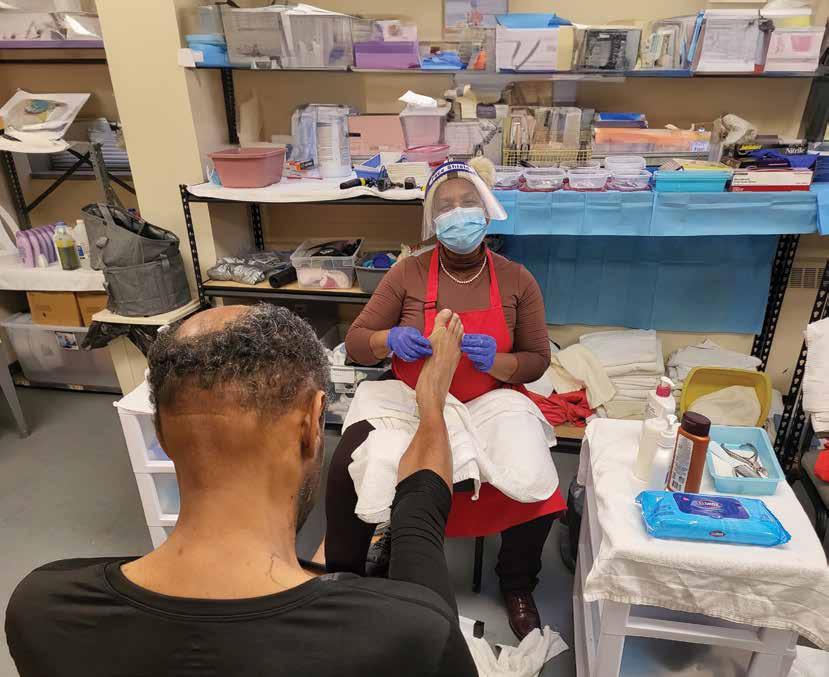 BY JOHN STEGEMAN
BY JOHN STEGEMAN
When Jesus washed the feet of his apostles, He showed them what it means to act with humility and love. In Cincinnati’s Over-the-Rhine neighborhood, Footcare for the Souls combines that selfless act with an effort to uplift and care for people in poverty.
Based in the St. Anthony Center near Liberty and Republic Streets, Footcare for the Souls is one of the St. Francis Seraph Ministries. On Tuesdays and Thursdays, people experiencing homelessness or poverty may come to the center to have their feet washed and treated.
Their experience starts with a soak and toenail trimming. Many clients experience skin breakdowns, ingrown toenails, fungus or other substantial problems, which can be treated at the center, said Executive Director Mary Pat Raupach.
She noted that Program Director Beverly Clayton is a nurse practitioner, and many volunteers also have medical experience, although volunteers without clinical experience are welcome and needed too.
Each client leaves with at least a fresh pair of socks and, sometimes, new shoes. “There’s such joy on some people’s faces,” Raupach said. “Some of them have been suffering with ingrown toenails or whatever their issue may have been for weeks. To see their faces as they leave… is very, very rewarding.”
For many clients, their visit to Footcare for the Souls is a respite from life on the streets; but for one recent client, it was a lifesaver. Josh* is an otherwise healthy man in his late 20s who arrived complaining of severe pain in both feet. After
14 |
THE CATHOLIC TELEGRAPH
Beverly Clayton, a nurse practitioner and Director of the Foot Care for the Souls program, ministers to a client.
removing the man’s socks, Clayton encountered the worst frostbite she’d ever seen, with significant skin damage.
Clayton knew the man needed more than the center could provide, but still applied topical antibiotics and wrapped his feet carefully. The staff called 911, and one of the firemen responders later told staff that Footcare for the Souls’ treatment likely saved Josh’s feet. Raupach said Josh still visits St. Francis Seraph Ministries.
“We’ve seen people [come] in that have had a really bad day, a really bad week or month,” Raupach said. “They’ve been on the street, terrible weather. They’ll go into that room, and they’ll come out transformed, calm, happy, joyful. Then they keep coming back … for routine care. We actually are hoping, at some point, to expand the program because we don’t have enough space for the demand. That’s how many people want it.”
“
They’ve been on the street, terrible weather. They’ll go into that room, and they’ll come out transformed, calm, happy, joyful.
St. Francis Seraph Ministries operates under the auspices of the newly formed Our Lady of Guadalupe Province of the Franciscan Friars. It manages several programs, including a dining room that offers free breakfast and dinner, Monday through Friday, to people in need. The ministries leverage the combined power of numerous nonprofits based in the St. Anthony Center.
Established in 2017, the St. Anthony Center is a collaborative effort to serve people experiencing homelessness in Cincinnati. Its current partners are: Center for Respite Care; Franciscan Ministries’ Haircuts from the Heart; Greater Cincinnati Behavioral Health Services; Mary Magdalen House; Welcome Home Collaborative; and St. Francis Seraph Ministries. While each is an independent entity, they refer clients to each other to best serve the clients’ needs.
“What we do is nourishing and nurturing,” Raupach said. “That can be done in so many ways: a listening ear, humor, music, friendship. That’s the goal of all of our programs.” Learn more about St. Francis Seraph Ministries at SFSministries.org.
*Name changed for privacy.

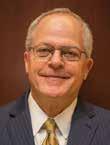

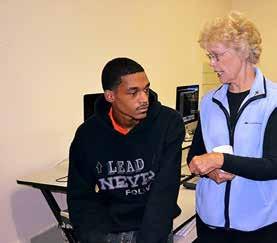
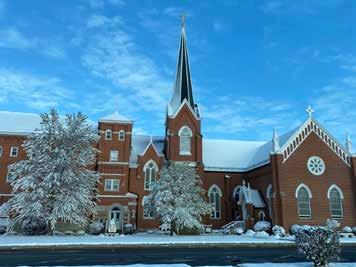





| 15
LENT + NEWS / MARCH 2024 Over 1,200 relics on display Offering our guests vital services: Foot Care for the Souls Mother Teresa of Calcutta Dining Room Sarah Center We nourish and nurture people in need. We appreciate your support! SFSMinistries.org Like the Precious Blood of Jesus, we live to be LOVE POURED OUT FOR ALL Sisters of the Precious Blood James E. Ghory, Jr. Senior Portfolio Manager Vice President | Financial Advisor 4380 Buckeye Lane, Suite 200 Beavercreek, OH 45440 937-431-7890 james.ghory.jr@morganstanley.com www.morganstanleyfa.com/james.ghory.jr NMLS #1657687 © 2022 Morgan Stanley Smith Barney LLC. Member SIPC. CRC 4210412 01/22 Catholic Values Investing Retirement Planning Professional Portfolio Management
Spiritual Centers
Whether it’s attending a retreat or wanting a moment to connect with God in nature, prayerful moments await throughout the archdiocese at area spiritual centers. These sacred spaces beckon believers to embark on a soul-nourishing journey by serving as havens for reflection and prayer. The archdiocese is blessed to have numerous centers, each with its own central mission and unique surroundings and experiences.
BY KARY ELLEN BERGER
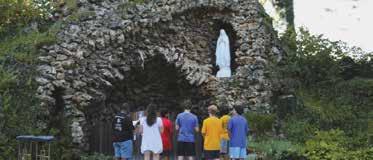
Bergamo Center
4400 Shakertown Rd., Dayton, 45430 | bergamocenter.org
The Bergamo Center extends hospitality in a spirit of peace and renewal on its campus adjacent to 50 acres of a wooded natural preserve.
“The Bergamo Center is set on the Marianist property of Mount Saint John, which is open to daytime visitors from sunup to sundown,” said Brent Devitt, Executive Director of the Bergamo Center.
Roughly 8,000 individuals and groups visit the Bergamo Center and its tranquil, natural environment annually. Its unique architectural design sets it apart, featuring a courtyard adorned with native plants and surrounded by 60 bedrooms.

5361
45150 | jesuitspiritualcenter.com
Guided by the mission to accompany individuals into a deeper relationship with God, the Jesuit Spiritual Center (JSC) offers transformative retreat experiences rooted in the Spiritual Exercises of St. Ignatius of Loyola. For almost a century, the center has been a steadfast companion on the spiritual journeys of countless seekers, providing a sacred space for reflection and communion.
“The JSC is unique in that we have a dedicated youth and adult ministry to host retreats,” said Sarah Vetter, Marketing Director at the JSC. “The JSC also partners with schools, churches and organizations to bring their retreat needs to life.”
Its five retreat houses and a chapel further enhance its versatile backdrop for a wide variety of spiritual retreats.

Maria Stein & Montezuma
2365 St. Johns Rd., Maria Stein, 45860 6731 OH-219, Celina, 45822 | spiritualcenter.net
Established in 1962, the The Spiritual Center in Maria Stein traces its roots to the Sisters of the Precious Blood. Five years ago, the Retreat House expanded, adding the Montezuma Retreat House.
16 | THE CATHOLIC TELEGRAPH
ARCHDIOCESE OF
CINCINNATI
Milford
Jesuit Spiritual Center at
Milford Rd.,
S.
Milford,
The Spiritual Center of
1 2
1 2 3 4 5
3
“We feel unique because we are located in a rural area and our retreat centers give people an opportunity to get away from their busy lives in a very quiet and very Catholic region of Ohio,” said Robin Goettemoeller, Coordinator of Retreat House. “The Maria Stein location is also unique because it is located next door to the Maria Stein Shrine of the Holy Relics, which houses the second largest collection of relics in the United States.”
The Retreat House annually hosts 15,000 guests and 30,000 meals. Retreats are held for adults and youth, including students from dozens of high schools.

Transfiguration Center for Spiritual Renewal
3505 Calumet Rd., Ludlow Falls, 45339 transfigurationcenter.com
Along the Stillwater River, you find the Transfiguration Center for Spiritual Renewal. This property boasts entities that include the Transfiguration Center for Spiritual Renewal, Elijah House, Melchizedek Village, Tabor Lodge for Priests and the River Ridge Nature Preserve. All resulted from a gift to the Church of the Transfiguration in West Milton.
“Transfiguration Parish is responsible for the preservation and the fulfillment of the will of Mrs. Kathryn Lange,” said Ron Mills, Director of the Transfiguration Center for Spiritual Renewal. “The Church of the Transfiguration, under the pastorship of Father Eric Bowman, is probably the only parish in the country that has been given the responsibility of running a retreat center and caring for priests in their retirement. In her last will and testament, Kathryn Lange expressed her desire that her estate be used to provide housing for retired priests of the Catholic Church, that the more than 160 acres of prairies and woods be preserved in their natural state and that her
home be used as a retreat center that people might enjoy the beauty and peace of this place.”
The center recently partnered with Ruah Woods Psychological Services to bring Catholic faith-informed mental health services to the northern part of the archdiocese.

Our Lady of the Holy Spirit Center
5440 Moeller Ave., Norwood, 45212 | olhsc.org
Our Lady of the Holy Spirit Center is dedicated to bringing people closer to God through prayer, reflection, education and sacraments. They offer retreats ranging from one day to one week, providing spiritual enrichment with continuous adoration, daily prayer, weekday Masses and weekly confession. The center also hosts educational and inspirational events throughout the year.
“Our Lady of the Holy Spirit Center offers so much more than just a room and space for meetings for retreatants,” said Dan Green, Managing Director. Judy Zarick, Director of Development & Communications of Our Lady of the Holy Spirit Center, agreed, “We offer 24/7 adoration, scheduled confessions; Mass two times a day, Monday through Friday and Saturday mornings; access to our reliquary with over 50 holy relics; our two beautiful outdoor courtyards; a library and media center; a gymnasium; holy artwork, statues, and mosaics all around the Center; and space to get away from the world and focus on your relationship with God.”
The center also hosts an Advent/Christmas event in the former seminary bowling alley, where the town of Bethlehem comes to life with over 50 actors engaging with visitors of all ages.
“THESE SACRED SPACES BECKON BELIEVERS TO EMBARK
ON A
JOURNEY.”
| 17 CATHOLIC SPIRITUALITY / MARCH 2024
SOUL-NOURSHING
4 5















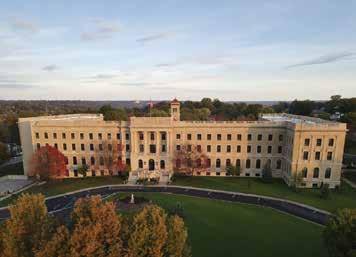






18 | THE CATHOLIC TELEGRAPH Transfiguration Center a beautiful place! 3505 Calumet Rd. | Ludlow Falls, OH 45339 (937) 698-7180 | www.transfigurationcenter.com Come experience the wonder of Transfiguration for your next group meeting or personal retreat. Mount Saint John offers 147 acres of natural beauty and peace just east of Dayton, OH. In our Marianist family spirit, we extend Mary’s welcome to God and to YOU for prayer, restoration, renewal, learning and encounter. Owned by the Marianist Province of the United States (Society of Mary, Brothers and Priests). Transforming society by building communities of faith that advance justice, peace, reconciliation, and the integrity of Creation. Everything should help us raise our hearts to God. – Blessed Adèle de Batz de Trenquelléon The Marianist Ministries of Mount Saint John Our Lady of the Holy Spirit Center Your ultimate retreat destination! 5440 Moeller Ave. • Norwood, OH • olhsc.org 24/7 Adoration WOMEN’S JOURNEY RETREAT Come to the Quiet Tend what is growing in you Tend what is growing in your soul through prayer, listening and reflection. Enter the silence and grow at your own pace. Among a community of women experience inspiring talks, nurturing scripture, times of silent reflection, Sunday Mass, opportunity for personal spiritual direction and more. For more information, contact: lriehle@jesuitspiritualcenter.com To register: reservations@jesuitspiritualcenter.com (513) 248-3500 A pril 26-28, 2024 FridAy, 5pm to SundAy, 1pm Jesuit Spiritual Center Loyola Building 5361 S. Milford Rd. Milford, OH 45150 Retreat Leaders: Cissy Eyre, Laura Riehle, Mary Ann Hegner, as well as a team of trained spiritual directors

CATHOLIC AT HOME
The Particularity of Holy Simplicity
For years I’ve moonlighted as a minimalist consultant, guiding clients as they simplify their possessions and demands on their time. Talking about simplicity makes me bubble over with enthusiasm, as when you share a life-changing book or a crowdpleasing recipe. You’ve found something so good that it’s hard not to talk about it.
Drawn to minimalism and simplicity for decades, after I digested a handful of books, blogs, and podcasts on the subject, I relentlessly pursued a smaller life more manageable for my family. What began as whittling away at excess possessions and clearing our space of “visual noise” morphed into deeply considering what God was asking of me. Already a wife and mother, I had a clear understanding that loving my husband and children needed to be at the top of my list. However, in addition to a vocation, the Lord blesses us with gifts and charisms—the things that make us feel more alive, the way people encounter Jesus through us.
I realized that how I pursue holy simplicity was to keep my vocation, gifts and charisms as reference points, then trim the fat. Whatever distracts from these reference points gets the boot, and the possessions and time commitments that contribute get to stay. While there is no shortage of literature or YouTube Channels specifying how to simplify your life, none have as their foundation God’s particular design and call for your particular soul. There is no one-size-fits-all (or even fits-most) approach, because quite truly, holy simplicity is as unique as our own souls.
Think of our brothers and sisters in heaven, gloriously donning an imperishable crown because they focused on whatever the Lord asked of them. St. Francis and St. Clare both forsook wealth and societal convention to radically rely on Providence. St. Benedict emphasized a life balanced with Ora et Labora, prayer and work. St. Elizabeth of Hungary was a wealthy queen who eagerly shared her majesty’s resources with her kingdom’s residents, to the criticism of courtiers and palace staff. St. Monica’s determination to faithfully serve her unfaithful husband and simultaneously supplicate Christ for her wayward son’s conversion made her a true conduit of God’s love and
mercy to the two important men in her life. These saints were made saints by accepting and obeying God’s will for their lives, trusting that only good would come from the One Who is love and mercy itself.
Though we know countless saints exhibited the same intent gaze on heaven, not a single one of them did it perfectly. They sinned, repented and sinned again until their days ran out; but that’s people. We know from every story of humanity, from Creation to present day, that the pursuit of things and a life outside of the Lord’s will for us consistently yields frustration, misery and sorrow. Remember Adam and Eve partaking of fruit clearly designated as off-limits. Think of Jonah who tried to outrun God’s request to help the Ninevites convert from their wickedness. Judas Iscariot traveled and worked with Jesus Himself, yet still vulnerable to even grave sin, committed the worst of betrayals in human history.
Simply put, in drawing close to Him in Whose image and likeness we are made, we become more like Him and more authentically ourselves. Life is more joyful despite its suffering. Conversely, going our own way and choosing our wants over God’s will effects interior chaos, as well as a propensity to brood over whatever we’re chasing. And once we get our hands on it, it won’t be enough.
I humbly submit this as an invitation. Who is it that your Creator made you to be? What sets your soul on fire? What do you need in your life to move forward with grace and become an increasingly better conduit of God to your nearest and dearest?
Begin there. The result of cutting loose that which fails to contribute to God’s loving will for our lives is clarity; that “I can finally breathe” feeling. Living with less yields so much more than you could ever expect.

KATIE
SCIBA
is a national speaker and Catholic Press Awardwinning columnist. Katie has been married for 15 years and is blessed with six children.
| 19 CATHOLIC AT HOME / MARCH 2024
spiritual direction
Walking your faith journey with accompaniment
BY EILEEN CONNELLY, OSU
Do you desire to deepen your relationship with God and be more attentive to His presence, activity and invitation in your life? Do you feel you could benefit from walking the spiritual journey, admittedly a lonely path at times, with someone who could affirm, clarify and even challenge you along the way? Then, spiritual direction could be of assistance to you on your faith journey.
It is important to note that spiritual direction is not pastoral or psychological counseling or confession. Rather, it focuses on a person’s relationship with God, including his or her prayer life and life experiences, said Sister Donna Steffen, SC, a longtime spiritual director and retreat leader. “The term itself is almost a misnomer, because one is not actually telling another person what to do, but listening to God’s action in the moment as we are meeting. The person brings what is going on with them, what they feel is significant. The belief is that God is alive in this person, and the director’s role is to assist them in finding that inner place where God is leading them and paying attention to that.”
“It is a learning process, a journey, as people tap into
their deepest life with God. It is lifegiving,” she added. “For a person who wants to grow in their relationship with God, this can be helpful.”
Spiritual directors are men and women, single, married, priests or members of religious communities, who underwent specific training to engage in this ministry. Many local spiritual directors received formal training at the Jesuit Spiritual Center in Milford, including Sister Steffen. She noted that when seeking a director, it is essential to ask candidates about their training, whether they did a practicum, where they received feedback and whether they had individual supervision.
This ministry is rooted in her own “very deep experiences of God that changed my life. I feel that God invited me into this journey,” she said. “It is so lifegiving for me to hear about people’s experiences with God, to encourage them, to support them. It feels like a gift and blessing from God that I did not create, but that God gave.”
Liz Tassone also refers to spiritual direction as a calling and gift from God, admitting she had no concept of what it was until introduced to it by a client at the
20 | THE CATHOLIC TELEGRAPH
radio station where she worked. “Walking with someone on their journey appealed to me,” Tassone said. “I wanted to experience that. She attended training through the Sycamore Spiritual Center in Louisville and has seen clients since 2010.
She recalls her son’s statement when she completed the program: “Now you get to tell people what to do.” “That has stayed with me, because that’s not at all what spiritual direction is about,” Tassone said. “It is about deep listening and letting that person speak from their life experience. I am just asking questions to help them go deeper and for them to know God’s presence. It is non-fixing listening. I do not think you get that [at] many places other than with a spiritual director.”
Sessions with a spiritual director create a space “where everything belongs,” Tassone said. “There is not a part of your life that does not belong. That space is held by the director in God’s love. I hope that is how I am holding the space when others are telling me their story.”
Tassone explained there are three chairs in spiritual direction: one for the director, one for the directee and a third for the Holy Spirit. “The Holy Spirit is the director, not me,” she said. “That feels so true.”
the ability to affirm the person and not engage in judgmental critiquing.”
In turn, Roche said, those seeking spiritual companionship “have to have a desire to grow and be open to God’s presence and compassion in the ways life presents itself to us, in the circumstances and the relationships that … challenge us to grow and mature. Life experience is such a profound teacher. Each of us has a unique contribution, our calling or vocation, to make in building up the reign of God, and that is affirmed in spiritual companioning.”
“I want to shout to the world that there are so many saints among us that we do not know about. There is so much good in the world,” said Tassone, reflecting on her experience as a spiritual director. “People are not perfect, but their love is perfect. In the space of their vulnerability in their relationship with God, I hear and smile at the beauty of His creation just yearning to please and to be held and loved. The sacred space that we occupy together is also part of my journey, and I am grateful for that.”
I am just asking questions to help them go deeper and for them to know God’s presence. It is non-fixing listening.
In her experience with her own spiritual director and what she has witnessed with her clients, she shared that “sometimes just speaking your truth aloud is one of the most freeing things you can do. We all need a place where we can have a compassionate listener, someone who is not judging everything you are saying. Part of the beauty of this ministry is speaking your truth in the presence of God’s love. The intent is not to fix, but to listen with compassion, and the Spirit will do what the Spirit will do. You are discerning God’s presence within your own life. It is right there.”
Dan Roche completed his training at Creighton University, and said he prefers the term spiritual companion over spiritual director, because it is a role in which one is accompanied rather than supervised. Those in this role should “practice what they preach, in a sense, practicing mindfulness and awareness,” he said. “The qualities of a good spiritual companion are their listening skills, their ability to listen at a deeper level and to really be able to hear God’s promptings from within the person and mirror back what they hear. They must have a non-anxious listening presence,

There is no one right way to go about finding a special director, but suggestions include asking your pastor or a trusted friend for a referral, inquiring through a reputable training program and praying for God’s guidance. Most directors do ask for a stipend since it is their primary ministry, and many will offer sliding scale fees.
The Archdiocese of Cincinnati Office for Consecrated life offers valuable resources for those seeking spiritual direction. Spiritual mentoring is another option, and sometimes a preliminary step for those seeking support as they begin to develop a prayer life, the essential foundation for spiritual direction.
School of Faith offers spiritual mentoring. To learn more and sign up: spiritualmentorship@schooloffaith.com.
Mary and Elizabeth is a group of spiritual directors for women. For more information, visit: https://maryandelizabeth.com/spiritual-direction-page/
Seek Direction is an online group designed to help Catholics find a spiritual director. The founders are practicing Catholics trained in Ignatian spiritual direction. Learn more at: https://seekdirection.app/#/home.
CATHOLIC SPIRITUALITY / MARCH 2024







SHORT. SIMPLE. INSPIRING. DAILY READING. REFLECTION. PRAYER.
Glenmary Home Missioners bring the Catholic Church to Mission Land, USA.
PRAY DURING LENT WITH OUR DAILY REFLECTIONS!
GLENMARY
HOME MISSIONERS

FREE TO YOUR INBOX!
Start your day with daily reflections written by the Glenmary family.
Reflections are available in English and Spanish and delivered each morning!
VISIT glenmary.org/signup
22 | THE CATHOLIC TELEGRAPH
4.0 x 5.0




A TREASURE TROVE OF PRAYER
Catholic Spirituality
In the mind of God, our Creator, we are each unique and unrepeatable creations. We are made in His image and likeness, of course, but each person has differing degrees of intelligence, methods of learning, gifts and creative ways of expression. It is no wonder, then, that our paths to God will be as different and unique as we are. Once we realize that God is our true end and feel that yearning in our soul to find Him, we will be on the hunt for the Truth. And once we find it in the Catholic Church, we will seek our rightful place among the many paths of spirituality or charisms that God provided for us, often through founders of religious orders. – Cynthia Montanaro
CATHOLIC SPIRITUALITY
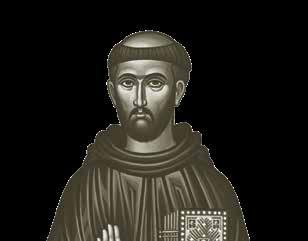



To understand Dominican spirituality, one needs to know the circumstances that prompted the founding of the Order of Preachers in the early 13th century.
St. Dominic founded the Order in 1216 in response to the Albigensian heresy spreading throughout southern France. Many people were falling prey to this heresy because of a lack of solid doctrinal preaching. Dominic proposed founding a new Order wholly dedicated to forming religious, through a life of contemplation and study, for the ministry of preaching. Contemplation of the Word of God and dedication to the study of sacred doctrine remain at the heart of Dominican spirituality.
A principal motto of the Order is “to contemplate, and then to share with others the fruits of one’s contemplation.” In other words, in Dominican spirituality, contemplation and prayer are not just a means for one’s personal spiritual growth, but are meant to lead to action: preaching, witnessing, sharing the faith with others. That said, commitment to a life of prayer must come first, for it is only when we devote time to prayer and meditation on the Word of God that we then have something worth sharing with others. Daily meditative reading of the
St. Dominic recognized that, although prayer and contemplation are the foundation for effective preaching, study of sacred doctrine and Church teachings is also necessary.
Dominican Spirituality
 BY FATHER JOHN LANGLOIS, OP
BY FATHER JOHN LANGLOIS, OP
Father Langlois resides at the Prior of the Dominican community at St. Gertrude in Cincinnati. He entered the Dominican Order in 1985 and was ordained to the priesthood in 1991. He has spent most of his priestly life teaching.
Word of God, or lectio divina, is a key element of Dominican prayer. But St. Dominic recognized that, although prayer and contemplation are the foundation for effective preaching, study of sacred doctrine and Church teachings is also necessary. The Albigensians he sought to convert back to the Church misunderstood and denied many of the faith’s central mysteries. It was necessary, then, for Dominic and his early companions to answer their questions intelligently and accurately. And so, Dominican spirituality is also marked by a commitment to intellectual formation in the faith.
Finally, Marian devotion, particularly praying the Rosary, figures prominently in Dominican spirituality. It is traditionally believed that when St. Dominic experienced difficulties in his preaching to the Albigensians, Our Lady appeared and revealed the Rosary to him, saying that if he prayed it, his preaching would enjoy greater success in obtaining converts. Historians today question this tradition’s veracity since it is not mentioned in the early documents of the Order’s history. Regardless, the reality is that Dominicans have been associated with promotion of the Rosary devotion since the early 15th century. And this makes sense, because the Rosary is primarily a prayer that aids contemplation.
Consisting of 150 Hail Marys, the Rosary was originally known as a “lay psalter” or the layperson’s way of imitating the prayer of monks, who chanted the Old Testament’s 150 psalms as their primary form of worship. Eventually, the 150 Hail Marys were divided into groups of 10, and “mysteries,” or significant moments in the lives of Jesus and Mary, were associated with each grouping. The idea was that the person praying the Rosary would meditate on a particular mystery, like the Birth of the Lord, while praying a decade of Hail Marys.
Through this contemplative prayer, focused on the Gospel, a person can come to a deeper appreciation for the life of our Lord, His saving mission and the purpose of our lives. The Rosary, then, is very much a Dominican way of praying, of coming to a deeper relationship with Jesus and Mary and of supporting Dominicans in their study, contemplation and preaching of God’s Word.
24 | THE CATHOLIC TELEGRAPH





In the mind of God, our Creator, we are each unique and unrepeatable creations. We are made in His image and likeness, of course, but each person has differing degrees of intelligence, methods of learning, gifts and creative ways of expression. It is no wonder, then, that our paths to God will be as different and unique as we are. Once we realize that God is our true end and feel that yearning in our soul to find Him, we will be on the hunt for the Truth. And once we find it in the Catholic Church, we will seek our rightful place among the many paths of spirituality or charisms that God provided for us, often through founders of religious orders.
“... we seek their help and want to become part of the “family,” to receive the community’s aid instead of wandering by ourselves.”
While some are called to the religious life as priests or nuns, most of us see our path in the ordinary realm of life, as husbands and wives, mothers and fathers, students, teachers and working folk. As we go about our days and seek Him with an open heart, striving to be the person He created us to be from the first moment of our existence, some of us discover that we are called to a vocation within our ordinary life’s vocation. Perhaps we are drawn to a deeper prayer life but need the help of professed obligations to live out such a life.
We of the Secular Discalced Carmelites see ourselves as such, under the protection and guidance of Mary,
Carmelite Spirituality
 BY CYNTHIA MONTANARO
BY CYNTHIA MONTANARO
Montanaro is a member of the St. Joseph Community of Secular Discalced Carmelites and a wife, mother of four boys and grandmother of seven. She prays, writes and gardens in Westfield, MA.
Our Lady of Mount Carmel, who constantly pondered in the heart, seeking in every occasion of activity or silence to know God and move toward His will with all the love of her heart. Some are drawn to this life after reading the works of our three Doctors of the Church: St. Teresa of Avila, St. John of the Cross and St. Thérèse of Lisieux. When we become interested in studying them, we want to know more about how to live the life they set forth.
With all our daily commitments, we often fail to make the effort, or we lose our way, so when we learn that others are on our same path, we seek their help and want to become part of the “family,” to receive the community’s aid instead of wandering by ourselves. We want to serve God in this life, to know the wonder of Him and to live out our lives with the love of Him in the forefront. And we are humble enough to seek help.
Carmelite Spirituality helps us in this love of God and in the service to the Church that is the fulfillment of this love. It begins with a deeper ecclesial life, a love for Christ in the Eucharist and the liturgical prayer of the Liturgy of the Hours. All focuses us on obtaining the love and grace to live out our vocation.
Secular Discalced Carmelites are members of a community of friends, holding fast to one another in our formation, to learn this life through the writings of our saints and blesseds and through community and discussion with our Order’s brothers and sisters. Our mission is to make God known as He should be known, to spread Carmelite spirituality, to meditate half an hour a day and to make a grand effort to meditate day and night through keeping recollected, meaning always in the Presence of God, whatever our outward tasks.
At our formation’s beginning, we receive a ceremonial scapular on our shoulders, study, discern and make temporary promises. We later make final promises to “tend toward evangelical perfection in the spirit of the evangelical counsels of chastity, poverty, obedience and of the Beatitudes, according to the Rule of St. Albert and the constitutions of the Secular Order of Discalced Carmelites for the rest of my life.”
| 25 CATHOLIC SPIRITUALITY / MARCH 2024




Franciscan Spirituality flows from the experience of a single man, St. Francis of Assisi (1181-1226). Son of cloth merchant Pietro Bernardone, St. Francis went from fighting for the values of wealth and fame to feeling contempt for those same values. After suffering for a year in an open pit prison from fear, cold, hunger and battle trauma, he emerged a changed man. Numerous transformational experiences over the next years molded him into the saint he is, and key themes arose from his life experiences that influence Franciscans to this very day.
First: A primacy for prayer. St. Francis heard Jesus’ voice from the San Damiano Crucifix say, “Go, repair my church, which as you can see is in ruins.” He experienced Christ fully in the Catholic Church, even though he recognized how bruised and broken the Church was. He and his brothers (in Latin, friars) regularly prayed the Office together and participated in Mass at various churches in the fields where they worked as day laborers. Here, Jesus continued to “come down upon the altar.” Here, “[Jesus] puts himself into (the priest’s) hands, and we touch Him daily with our mouth.” St. Francis reminded the friars: “Look, brothers, at the humility of God and pour out your hearts before Him.” “Hold back nothing of yourselves for yourselves, so that He Who gives Himself totally to you, may receive you totally.” These words demonstrate St. Francis’ passion for the Eucharist, the Church and that central relationship with Jesus Christ.
Second: An astonishment for God’s love. St. Francis sought solitary places to spend long hours in prayer, where he met the humble Christ. Jesus’ Incarnation as a “Bethlehem Babe” held a prominent place. That God desired to love us so much to become one of us, in our human flesh, always astounded St. Francis. He wanted
Franciscan Spirituality
BY BROTHER MARK SOEHNER, OFM

Brother Mark Soehner professed temporary vows with the Franciscan friars in 1981, solemn vows in 1985, and was ordained to the priesthood on June 13, 1987, at St. Francis Seraph Parish in Cincinnati. He is the current Provincial Vicar for the recently unified, coast-to-coast Province of Our Lady of Guadalupe.
to demonstrate this great love. In 1223 in Greccio, where the peoples’ hearts had grown cold, he reconstructed the manger scene in a cave with barn animals. In this spot, during the Christmas Mass, people saw in St. Francis’ arms what seemed like a lifeless baby awaken from a deep sleep—the whole village went home singing!
Third: An appreciation for Creation. Franciscans see that as God became flesh for us in Jesus—all of God’s creation reflects the magnificence of God. In his Canticle of the Creatures, St. Francis praises God through the “creatures,” understanding them as brother or sister. His love for nature was expressed with deep familial connection.
Fourth: A recognition of Jesus’ humility. In the Eucharist, the Christmas crib and all of creation, St. Francis noticed the humility of God in Jesus. The hands that once held moon and stars grasped Mary’s little finger and would stoop to wash our feet. As Franciscans, we fall in love with this humble God and stop our ambition to be among the clever.
Fifth: Jesus in the suffering. St. Francis encountered this Jesus in a poor beggar in Rome with whom he exchanged his clothes and in the leper he embraced. Sometimes, we try to find God in an antiseptic church, and we trip over God lying on the church steps or in the pain in our lives. St. Francis discovered God in his own poverty, his woundedness, and he taught us what to do with our pain. Rather than passing it along, the worst pain can become a sacred wound, a gate of heaven, when we learn to embrace it with Christ, touch it to His wounds.
The Franciscan friars, sisters and seculars continue looking to the needs of those on society’s periphery. Historically, we have cared for people whom the world despises: families living below the poverty line, the homeless, the mentally ill. We are psychologists, scholars, lawyers, teachers and any profession—even priests! While some have spent time in hermitages for deeper prayer, we live in fraternities, where we daily pray and cook together and invite others to join with us, as a family would. We are bound together by vows of poverty, chastity and obedience. We listen for the Spirit, especially with a view towards those who struggle on the edge of our world.
26 | THE CATHOLIC TELEGRAPH




On May 20th, 1521, a fiery young man named Íñigo López de Oñaz y Loyola—better known to us as St. Ignatius of Loyola—was injured in a battle at Pamplona in Spain. In the long months of bedrest and boredom during his convalescence, Ignatius either daydreamed about great romances and adventures or read and reflected upon two books given to him—on the life of Christ and the lives of the saints. Noticing the romantic fantasies ultimately felt hollow and boring, while reflecting on Christ and the saints kept him energized and satisfied even after he completed them, he paid careful attention to his interior movements. By the time he was back on his feet—enduring a permanent limp from his injuries—he forsook his nobility and wealth and made his way as a poor pilgrim and beggar.
“Ignatian spirituality seeks to discern and notice God present and laboring in our everyday lives...”
For a year he lived in nearby Manresa, spending several months praying and fasting in a nearby cave, sometimes praying up to seven hours a day. During this time he developed what would become his famous Spiritual Exercises
Because the importance of his own personal experience came to form the DNA of Ignatius’ spirituality, personal experience is the very matter of such Ignatian practices as the Daily Examen, the Spiritual Exercises and even Ignatian Contemplation. He came to understand that God is not only constantly laboring on our behalf, but also desires that we labor with
Ignatian Spirituality
 BY FATHER JACOB BODDICKER, SJ
BY FATHER JACOB BODDICKER, SJ
Father Boddicker is a Jesuit priest serving at St. Xavier Church in downtown Cincinnati. Originally from Tipton, IA, he entered the Society of Jesus in 2006 and was ordained in 2017. Prior to his current assignment he served as a pastor on the Rosebud Indian Reservation in South Dakota as part of the St. Francis Mission.
Him. Ignatian spirituality seeks to discern and notice God present and laboring in our everyday lives, such that in becoming more attentive to His Spirit’s movements in our hearts and souls, we come to know how He desires us to serve alongside Him. By this we come to know Jesus on a deeply personal level, in a relationship such as the apostles themselves enjoyed, that not only may we come to know and love Him, but we might likewise go into the world and make Him known to others; speaking not only from our knowledge of the faith, but our lived experience of Him.
How does one practice Ignatian Spirituality? There are many online resources, but the fundamental practice—so important that St. Ignatius exhorts a Jesuit never to miss practicing it, no matter how busy he may be—is that of the Daily Examen. Find a place that is quiet and conducive to prayer, and set aside five, 10, 15 minutes, or whatever brief time you have. Then:
1. Place yourself in God’s presence, and thank Him for everything He has done for you.
2. Ask Him to enlighten your mind, heart and soul to better notice and understand how He has been at work in your life.
3. Review your day, or since the last time you prayed the Examen, until the present moment. Recall specific moments and what you experienced in them.
4. Reflect on some of those specific experiences: Where did you experience God’s presence and love; how did you respond? Where did you experience His absence, distance; where did you move away from Him? Ask His forgiveness for any moments of sin.
5. Look ahead to tomorrow: What are you anxious about or looking forward to? What do you want His help with or want to talk to Him about? Make a resolution about how you plan to confront one future thing with His help.
6. Conclude by praying the “Our Father.”
| 27 CATHOLIC SPIRITUALITY / MARCH 2024
ST. JOSEPH PROTECTOR OF THE HOLY FAMILY CARMELITE COMMUNITY
rooted
in the language of the soul
 BY MATT HESS
BY MATT HESS
Carmelite Spirituality is one of the oldest in the Catholic tradition, having roots in the Old Testament with the prophet Elijah. His witness inspired hermits to live on Mount Carmel, the tradition was carried to Europe and reformed in the 16th century, and the spirituality continues to be lived out to this day throughout the world.
In the Archdiocese of Cincinnati, there are groups of lay faithful who feel called to deepen their prayer and understanding of the Lord in this spirituality through Secular Carmelite Communities. In the northern part of the archdiocese, they formed the St. Joseph, Protector of the Holy Family Carmelite Community.
Julia Monnin, the Director of Formation for the Secular Carmelites in this local community, notes that Carmel’s mission is “to know God that He may be known.” Through prayer, each believer encounters God, and there are several prayer forms in the western tradition. These practices were picked up, used and commented on by saints of the Carmelite Order. Monnin notes, “Whether or not you are called to Carmel, we are all called to a life of prayer, so there is something we can all gain from it.”
While members are not sisters, brothers or priests, they make promises of poverty, chastity and obedience that enable them to be active members in the Order’s life. They live in the modern world, taking their spirituality to the street and allowing it to shape their encounters with others.
Norma Wermert and Kathy Homan, two of the Community’s founding
members, agree that their spirituality gives their day “rhythm.” “He calls us just to be with Him,” said Wermert, “The whole day is a prayer.” Homan added, “What we receive in prayer we give to others.”
The Carmelite spirituality’s flexibility makes it a natural fit for lay people seeking a life of prayer within their modern lives’ circumstances.
Joining the Secular Carmelites involves many years of formation, as their way of life is grounded in reading the spiritual masters and requires daily time with God in quiet meditation, morning and evening prayer, Holy Mass and devotions to the Blessed Mother. Formation and temporary vows last about six years to help candidates ease into this life. In monthly community meetings for formation, members share their life’s journey to a deeper
Interested in the Secular Carmelites, but don’t know where to start?
• Visit the Province website: www.ocdswashprov.org
• Talk to groups in Celina, Beavercreek, and Cincinnati about community Come & See Days
• Try reading St. Therese’s Story of a Soul
• Talk to a pastor or spiritual director
28 | THE CATHOLIC TELEGRAPH
{ }
relationship with the Lord. The St. Joseph, Protector of the Holy Family Community has just over 30 members, having grown considerably since its founding in late 2015. This particular community also puts on an autumn retreat for the local community as part of its apostolate to share their spirituality.
Wermert and Homan began attending Carmelite meetings in Columbus before there was a stable group in the area. Reading Carmelite saints led Homan to desire entering into this way of life, “That first meeting felt like home.”
This cohort offers support, accountability and stability to those ascending Mount Carmel.
Monnin found Carmel by a different path; in some ways it was the community who found her. After growing in her faith, her spiritual director urged her to see what the Carmelites were about. Monnin knew she was ready for a new challenge and began formation, saying, “I was a fish out of water who had found water.”
Whether or not you are called to Carmel, we are all called to a life of prayer, so there is something we can all gain from it.
Father Jedidiah Tritle, parochial vicar of the C-1 Family of Parishes and spiritual assistant to the St. Joseph Protector of Families Community, recalled that Carmel’s seed was planted in him when he read Story of a Soul by St. Thérèse of Lisieux during his diaconate study in seminary. He discerned with the Carmelite Order for a time, and finds Carmelite principles useful in his role as a diocesan priest.
“At the center of a priest’s identity is conformity to Christ and His Church,” said Father Tritle “For this to grow and flourish, it is necessary to be rooted in a life of prayer. Carmelite Spirituality is an opportunity to do that.”
Ascending Mount Carmel can be a daunting task to people in the pews who have not heard of St. Teresa of Avila or St. John of the Cross. There is both a simplicity and depth to the Carmelite way of life that is depicted by its saints. With a little help and a bit of perseverance, everyone can find a piece of this spirituality to bolster their faith. “We are not elitist or Gnostics,” said Father Tritle. Rather, a Carmelite Spirituality is “a language of the soul and a path of love.”





| 29 CATHOLIC SPIRITUALITY / MARCH 2024
Celebrating FOR 150 YEARS OUR GOAL HAS BEEN THE SAME ST. JOSEPH HOME REMAINS A PLACE TO SERVE THE MOST VULNERABLE IN OUR COMMUNITY 10722 WYSCARVER RD, CINCINNATI, OH 45241 To support our mission, please give at stjosephhome.org/donate or call us at (513) 563-2520 • Personalized post-mastectomy and post-lumpectomy services • Custom breast forms, breast prostheses, bras, camisoles, post-mastectomy swimwear, and post-surgical garments www.personalsymmetrics.com Call Tammy or Kathleen for an appointment (513) 221-7200
St. Ann, Hamilton
BY GAIL FINKE ILLUSTRATED BY EMMA CASSANI
Did you know St. Ann Church, Hamilton, was in grave danger of being closed after just five years as a parish, when its construction debt was two years in arrears and amounted to a whopping $350 (almost $10,400 today) per parishioner?
DID YOU KNOW?




St. Ann, Mary’s Mother
Extra-Biblical sources and traditions name the Blessed Virgin’s parents as Joachim and Ann, who were elderly when the Blessed Virgin was born. Their feast day is July 26. St. Ann is commonly depicted as a gray-haired woman teaching her young daughter to read.
Lindenwald
Now Hamilton’s largest neighborhood, Lindenwald was a stop on the Cincinnati, Hamilton & Dayton Railroad and was annexed to the city in 1908.
1908
St. Ann organized as a mission of St. Joseph Church for the growing Lindenwald area. First Mass celebrated on the Feast of St. Ann in a rented home converted for use as a church.
1909
St. Ann established as a parish with a resident pastor. Rented home divided, with school on one side and pastor’s residence upstairs.
1910
Work begun for new parish and school building. First Mass celebrated on Christmas day in the basement, which continued as the church for decades.
1914
First of several missions held to increase membership. Many area Catholics had never attended Mass there, or anywhere, for years. Parish finances slowly improved.
1921
Convent built for the school’s teachers.
1936
Construction begun for current church, designed by architect Edward Schulte, in a unique combination of styles. Indiana limestone exterior is largely Streamline Art Deco, while interior is modified Gothic Revival. Elaborate woodwork

1938
Bell tower removed from school building, which no longer doubled as a church.
“A lot of churches don’t have real candles anymore, but it’s a good tradition and fits here — it’s ‘old school,’ like the kneelers. There’s a lot of detail in the stained glass and wood carvings and architecture, especially if you look up to the ceiling. Most of the parishioners have been here their whole lives. It’s a warm and inviting parish.” - Julie Kluesener, Administrative Assistant
Fort Hamilton
Founded in 1791 and named after Alexander Hamilton, Fort Hamilton was abandoned after the 1796 Treaty of Greenville, but the area remained in use for trade and farming. Incorporated as the City of Hamilton in 1810, by the mid-1800s it had become a major manufacturing center attracting German, Italian and Jewish immigrant workers.
Quick Facts
10 tall Gothic side windows in a modified art deco style showcase predominantly blue-toned glass, depicting St. Joseph, St. Anne, St. Peter, St. Thomas Aquinas, Simeon, Mary as the New Eve, Christ as the New Moses, the Holy Family and a woman symbolizing the Church.
4 side altars with candles are devoted to Joseph, the Sacred Heart of Jesus, Mary and St. Ann.
30 | THE CATHOLIC TELEGRAPH
throughout carved by E. Hackner Altar Co. in La Crosse, WI.

As a priest and punk rocker who, through loud, angry music, found meaning and hope in the midst of suffering, I was overjoyed to discover Walk the Line: Rock Music and the Christian Imagination. This collection’s essays delve into particular songs and various artists’ work to find expressions of the Christian imagination. The result is edifying, fun to read and provides a template for the reader to consider other music in the same, theologically-minded way. In the introduction, Editor Father Christian Raab, OSB, describes the book as using “theological reflection to help people listen to secular music in a new way,” a goal I believe is truly important in our current day and age.
Walk the Line’s authors engage a wide array of musicians and rock genres. All of rock music’s history is fair game, from its roots in soul and blues, through the Beatles and Bob Dylan, to younger lesser known artists. Each chapter dives into its subject matter with attention to detail and an openness to really hear what each musician has to say, creating an honest and deep conversation between Catholic doctrine and our modern day poets.
The exposition of Catholic tradition side-by-side with popular lyrics is especially gratifying. For example, St. Augustine’s words are frequently compared to the powerful desire expressed in rock’s love songs. Ancient heretics’ errors are examined next to competing ideas of truth in modern society and music. U2’s message is read next to Richard Rohr and ancient Gnostic doctrines. This practice of seeing music through Christian eyes, open to the world but formed by the lens of truth, is critical in the modern world.
BOOK REVIEW
Walk the Line
Rock Music and the Christian Imagination
edited
by
Christian Raab, OSB
REVIEWED BY FATHER AMBROSE
DOBROZSI
My only criticism is that the essays in Walk the Line tend to engage with the lyrics but not the music. The musical decisions about what a song should sound like are essential to rock’s significance. For example, the chapter on Sara Barreilles’ “Brave” presents a dynamic inquiry into the concept of “truth” behind the song’s admonition to speak the truth to power, in the context of the “Me Too” movement. But “Brave” is a pop song, with the modern pop’s characteristic sound that is carefully curated to appeal to a mass market. At best, this is in tension with the song’s indictment of that very commercial culture. The decision to make the song sound like a pop anthem affects its meaning, but this dilemma is not noted in the book.
Some of the collection’s authors better engage the musical aspect of the songs and artists they discuss. Overall, though, I would also have enjoyed a deeper look into the music along with the excellent discussion of the lyrics.
I greatly enjoyed reading Walk the Line and recommend it. In our secular culture, identifying and benefiting from the theological ideas behind pop culture is an essential skill. This book is a delightful exercise in that skill.
Father Ambrose Dobrozsi is a priest of the Archdiocese of Cincinnati and the parochial vicar for the NE-3 Family of Parishes.
| 31
Christian Raab, OSB, editor; Walk the Line: Rock Music and the Christian Imagination; New City Press, 2023; 260 Pages; $24.95
BOOK REVIEW / MARCH 2024

ST. JOSEPH’S TOOL BELT
Saint Joseph: Why Him?
When younger, I never imagined myself as a husband and dad. All I wanted was to travel—like rugged, vagabond travel— and capture stories of religious minorities in war zones. The thought of settling down and living a white-picket-fence life, to me, was counter to living life to its fullest—it was bland, uninteresting, unremarkable and lacking depth of meaning
When I returned to the Church in college though, life began directing me down the path to family life—a path I did not ask for but welcomed, because I was trying to seek God openly. And, unexpectedly, simply planning my wedding became an interesting experience. Raised in a family where married men had plain, flat, gold rings, that was perfectly normal, beautiful even. My wife, however, pressed me to pour more meaning into it. I thought of the men who profoundly impacted me: my dad, grandpa, mentors, priests, the list went on, even including fictional men like Jonathan Kent, Superman’s father.
Sharing with my wife both the list and an idea to engrave the ring with the first letter of their names, she acknowledged these men’s value in my life but offered St. Joseph as a singular alternative. I was silent. Why him? I thought, “There’s nothing remarkable about him. Nothing inspiring. Nothing that lifts my soul and enkindles the oomph to do what must be done, regardless of how I’m feeling.”
We talked more, and her encouragement prompted me, leading up to our wedding, to start the St. Joseph consecration.
All my life I felt a profound pull toward God the Father, as one standing in awe and feeling content and loved. Yet, I also longed to hold Him and be physically held by Him, and to put a face to the God I loved.
In stepped Joseph, and my life changed forever. In him, I found God the Father speaking to me in a radical, new way. St. Joseph became my constant companion. I saw that, beyond Christ, there is no man more noteworthy, more accomplished in character and virtue, than the savior of the Savior, St. Joseph.
When our daughter was born, she entered life with the umbilical cord around her neck. It was terrifying! Who did I called on for help in that moment? Joseph. And who followed through? Joseph. Our little girl has been an unbelievable gift in our lives. Guess what happens to be her favorite toy? A little stuffed carpenter named Saint “Jojo.”
Since then, whenever I find my family or myself cornered with no escape in sight, Joseph has never let me down. Everything I have is from his intercession, from his Holy Family’s care. What my wife gave me in St. Joseph was the greatest gift I ever received, beyond Baptism and the Eucharist, and my wedding ring now reflects this with one diamond for Jesus and one for Mary, set on either side of a blue sapphire for Joseph.
I didn’t imagine my life would take this turn, but I thank God it has, challenges and all. Through St. Joseph and his Holy Family and through my own wife and family, I found God. I have yet to uncover the depths of meaning and life these people give me, and I doubt I ever fully will.

TRENTON SCROGGINS
is the Director of Digital Engagement for the Archdiocese of Cincinnati. tscroggins@catholicaoc.org
32 | THE CATHOLIC TELEGRAPH
St. Joseph carrying the Child Jesus by Pieter van Lint.
Ascension Church (Kettering)
Feb. 16; 4:30–5:30 p.m., Carryout: 6–8 p.m.
Carroll High School St. Pat’s Irish Fish Fry (Dayton) | March 8; 6 p.m.–midnight, Carryout: 4:30–5:30 p.m.
Catholic Kolping Society (New Burlington) | Feb. 16, 23, March 1, 8, 15; 5:30–7:30 p.m.
Chaminade Julienne High School (Dayton) | March 16; 6 p.m.
Church of the Transfiguration (West Milton) | Feb. 16; 6–9 p.m.
Church of the Visitation of the BVM (Eaton) | March 8, 15, 22; 5 p.m.–7 p.m.
Good Shepherd (Cincinnati) | Feb. 16, 23, March 1, 8; 5–7:30 p.m.
Guardian Angels (Cincinnati)
Feb. 16, 23, March 1, 8, 15, 22; 5–7p.m.
Holy Cross Immaculata (Cincinnati)
March 29; 4 p.m.
Holy Family Knights of Columbus (Middletown) | Feb. 16, 23, March 1, 8, 15, 22; 5–8 p.m.
Holy Name of Jesus (Trenton) | Feb. 16, 23, March 1, 8, 15, 22; 5–7 p.m.
Holy Trinity (Norwood)
Feb. 17; 5–7 p.m.
Holy Trinity (Dayton)
Feb. 24; 6:30– 8:30 p.m.
Immaculate Conception (Celina)
Feb. 16, 23, March 1, 8, 15, 22; 5–7 p.m.
Immaculate Heart of Mary (Anderson Twp.) | Feb. 16, 23, March 1, 8, 15, 22; 4:30–7 p.m.
Knights of Columbus #1683 (Northside)
Feb. 16, 23, March 1, 8, 15, 22, 29; 5–7:30 p.m.
Knights of Columbus #1592 (Saint Marys) | Feb. 16, 23, March 1, 8, 15, 22; 4:30–7 p.m.
FISH FRIES in the archdiocese
Knights of Columbus #624 (Springfield)
Feb. 16, 23, March 1, 8, 15, 22; 6 p.m.
Knights of Columbus #1272 (Wapakoneta)
Feb. 16, March 1, 15, 29; 4:30–7 p.m.
Knights of Columbus at St. Paul (Englewood) | Feb. 16, 23, March 1, 8, 15, 22; 5:30–7 p.m.
Nativity of Our Lord (Cincinnati)
Feb. 16, 23, March 1, 8, 15, 22; 5:30–8:30 p.m.
Old St Mary’s (Over-the-Rhine) | March 1 (on Bockfest Parade Route); 5 p.m.
Our Lady of Sorrows (Monroe) | Feb. 16, 23, March 1, 8, 15, 22; 4:30–7:30 p.m.
Our Lady of the Rosary (Greenhills)
Feb. 23, March 8, 22; 5–7 p.m.
Our Lady of the Valley (Reading)
Sts. Peter and Paul Campus | Feb. 16, 23, March 1, 8, 15, 22; 5–7 p.m.
Our Lord Christ the King (Mt. Lookout)
Feb. 16, March 1; 5–7:30 p.m.
Queen of Peace (Hamilton)
Feb. 16, 23, March 1, 8, 15, 22; Drive-thru Only: 4–7 p.m.
Sacred Heart KofC #8115 (Fairfield)
Feb. 16, March 8, 29; 5:30–7:30 p.m.
Sacred Heart (New Carlisle)
Feb. 16, 23, March 1, 8, 15, 22; 5–7 p.m.
St. Aloysius Gonzaga (Bridgetown)
Feb. 16, 23, March 1, 8, 15, 22; Drive-thru only: 4:30–7 p.m.
St. Aloysius (Shandon)
Feb. 16, 23, March 1, 8, 15; 4:30–7 p.m.
St. Ann (Hamilton)
March 22; 5–11 p.m.
St. Anthony of Padua (Dayton)
Feb. 24; 6–11 p.m.
St. Antoninus (Cincinnati)
Feb. 16, 23, March 1, 8, 15, 22; 5–7 p.m.
Scan for all the details and most up-to-date fish fry information!

St. Benedict the Moor (Dayton)
Feb. 16, 23, March 1, 8, 15, 22, 29; 11 a.m.–6 p.m.
St. Bernard (Spring Grove Village)
Feb. 16; 5:30–7:30 p.m.
St. Boniface (Northside)
Feb. 16, 23, March 1, 8, 15, 22; 5–7 p.m.
St. Brigid (Xenia)
March 1; Carry Out: 4:30–11 p.m.
St. Catharine of Siena (Westwood)
St. Catharine School, Feb. 16, March 1, 8; 5–7 p.m.
St. Cecilia (Oakley)
March 1; 5–7:30 p.m.
St. Charles Borromeo (Kettering) March 15; 7 p.m.
St. Christopher (Vandalia) | Feb. 16, 23, March 1, 8, 15, 22; 6–7:30 p.m.
St. Columban (Loveland)
Feb. 16, 23, March 1, 8, 15, 22; 5–7:30 p.m.
St. Columbkille KofC #3369 (Wilmington) | Feb. 16, 23, March 1, 8, 15, 22; 4:30–7 p.m.
St. Elizabeth Ann Seton (Milford) Feb. 16, 23, March 1, 8, 15, 22; 5–7:30 p.m.
St. Francis of Assisi (Centerville) March 22; 4:30–11 p.m.
St. Francis de Sales (Lebanon) Feb. 23, March 1, 8, 15; 5–7 p.m.
St. Gertrude (Madeira)
Feb. 16, March 1, 15; 5–7:30 p.m.
St. Ignatius of Loyola (Monfort Heights) Feb. 16, 23, March 1, 8, 15, 22; 5–7:30 p.m.
St. James of the Valley (Wyoming) March 8; 5–7 p.m.
St. James the Greater (White Oak)
Feb. 16, 23, March 1, 8, 15, 22; 4:30–7:30 p.m.
| 33 FISH FRY GUIDE / MARCH 2024
St. John Neumann (Cincinnati)
Feb. 16, 23, March 1, 8, 15, 22; 4:30–7 p.m.
St. John the Baptist (Dry Ridge)
Feb. 16, 23, March 1, 8, 15, 22; 4:30–7:30 p.m.
St. John the Evangelist (Deer Park)
March 15, 29; 5:30–7:30 p.m.
St. John the Evangelist (West Chester)
Feb. 16, 23, March 1, 8, 15, 22; 4:30–7 p.m.
St. Lawrence (Price Hill)
Feb. 16, 23, March 1, 8, 15, 22; 5–7 p.m.
St. Louis (Owensville)
Feb. 23, March 1, 8, 15; 5–8 p.m.
St. Margaret of York (Loveland)
Feb. 16, 23, March 1, 8; 5–7:30 p.m.
St. Mary (Bethel)
Feb. 16, 23, March 1, 8, 15, 22; 4:30–7:30 p.m.
St. Mary (Hyde Park)
March 22; 5–7:30 p.m.
St. Mary (Piqua) | Feb. 16, 23, March 1, 8, 15, 22; 5–7 p.m.
St. Mary KofC #1727 (Urbana) | Feb. 16, 23, March 1, 8, 15, 22; 5:30–7 p.m.
St. Mary of the Woods KofC #4378 (Indian Lake) | Feb. 16, March 8, 29; 4:30–7 p.m.
St. Maximilian Kolbe (Liberty Twp.)
Feb. 16, 23, March 1, 8, 15, 22; 4:30–7 p.m.
St. Michael (Sharonville) March 1, 8; 5–7 p.m.
St. Michael (Mt. Orab)
Feb. 16, 23, March 1, 8, 15, 22; 4:30–7:30 p.m.
St. Patrick KofC #1782 (Bellefontaine)
Feb. 16, 23, March 1, 8; 5–7 p.m.
WE BUY OLD CATHOLIC BOOKS!

St. Peter New (Richmond)
Feb. 16, 23, March 1, 8, 15, 22; 5–7:30 p.m.
St. Saviour (Sycamore Twp.)
Feb. 16; 5–7:30 p.m.
St. Susanna (Mason)
Feb. 16, March 1, 8, 15; 5–8 p.m.
St. Thomas More (Withamsville)
Feb. 16, 23, March 1, 8, 15, 22; 5–7:30 p.m.
St. Veronica (Mt. Carmel)
Feb. 16, 23, March 1, 8, 15, 22; 5–7:30 p.m.
St. Vincent Ferrer (Kenwood)
March 1, 8, 15; 5:30–7:30 p.m.
St. William (Price Hill)
Feb. 16, 23, March 1, 8, 15, 22; 4–7:30 p.m. (Drive-thru only) KUBIK
24 Park Ave., Dayton, OH 937-294-0253 | mail@kubikbooks.com
One of the nation’s premiere sellers of used, rare & vintage books. Estates and collections of Catholic and other vintage books wanted!



34 | THE CATHOLIC TELEGRAPH
FINE BOOKS LTD
FRIDAY NIGHT FISH FRY

1199

Enjoy unlimited soup, salad, and seafood every Friday during Lent including grilled shrimp, grilled fish, fried fish, hush puppies, and more.
*Available at participating locations.

Catch Our
LEMON PEPPER
FISH SANDWICH
*Available everyday for a limited time.


POPE ST. JOHN PAUL II’S THEOLOGY OF THE BODY
The Body and Purity of Heart
Note: This article is part of an ongoing series on Pope St. John Paul II’s “Theology of the Body” (TOB).
In Matthew 5:27-28, Jesus reaffirmed the sixth commandment and brought it to fulfillment by teaching that one must refrain not only from overt acts of adultery but also the interior act of adultery in the heart. As we saw last month, this adultery in the heart consists of looking at another in a reduced way, seeing his/her body merely as an object by which I might satisfy my sexual urge. When I allow myself to look at and think about others in this way, I fail to regard them as persons made in God’s image and possessing inestimable dignity. I also lose sight of the spousal meaning of the body, which signifies that through the body and sexuality a man and a woman can make a total gift of self, forming a communion of persons in the context of lifelong marriage.
According to Pope St. John Paul II, adultery in the heart can even occur within marriage. Taking the example of a man looking lustfully at a woman, “Even if he were to look in this way at the woman who is his wife, he would commit the same adultery ‘in the heart’” (TOB 43:2).
This surprising teaching may lead some to conclude that the Catholic Church has a dim view of the body and sexuality, perhaps seeing them as “bad” or “sinful.” This could not be further from the truth. Rather than seeing in Christ’s teaching on adultery in the heart “a ‘condemnation’ or accusation of the body,” Pope St. John Paul II saw an “affirmation of the body as an element that, together with the spirit, determines man’s ontological subjectivity and participates in his dignity as a person” (TOB 45:1). In other words, the body is integral to who we are as human persons, and it shares in the dignity we have as sons and daughters of God. The body reveals the person. When we see a living human body, we see a person made in God’s image, and what we do to the body, we do to the person.
For this reason, the Church also lifts up the value of sexual intimacy, seeing it as deeply personal and dignified. Through conjugal relations, man and woman engage in a total gift of self that has the capacity to effect an indissoluble sacramental bond. Far from seeing them as “bad” or “evil,” John Paul II taught that the body and sex “remain ‘a value not sufficiently appreciated’” (TOB 45.3).
Nonetheless, we all experience tensions, struggles and temptations to lust. These do not come from the body per se, but from the fallen human nature we inherit. Due to original sin, all of us experience concupiscence (i.e., disordered desire), which pulls us in various ways to selfish ends, thereby falling short of God’s law. Indeed, out of our wounded hearts come all manner of sinful thoughts and urges (cf. Mt. 15:19). For this reason, Jesus Christ came to redeem us and give us new life. The whole human person is called to participate in this redemption, including the body and sexuality. However, it is the heart, most of all, that Christ desires to possess and transform. This inner renewal is the foundation of all Catholic sexual ethics:
“The Christian ethos is characterized by a transformation of the human person’s consciousness and attitudes… such as to express and realize the value of the body and of sex according to the Creator’s original plan” (TOB 45.3).
Christ’s commandment on adultery in the heart is a call to us for inner transformation. As Pope St. John Paul II taught, “One fulfills the commandment by ‘purity of heart’” (TOB 43:5). Let us, then, continue to ponder the meaning of purity of heart and the redemption of our bodies and sexuality.

DR. ANDREW SODERGREN, MTS, PSY.D. is a Catholic psychologist and director of psychological services for Ruah Woods. He speaks on the integration of psychology and the Catholic faith. He and his wife, Ellie, have five children.
36 |
THE CATHOLIC TELEGRAPH

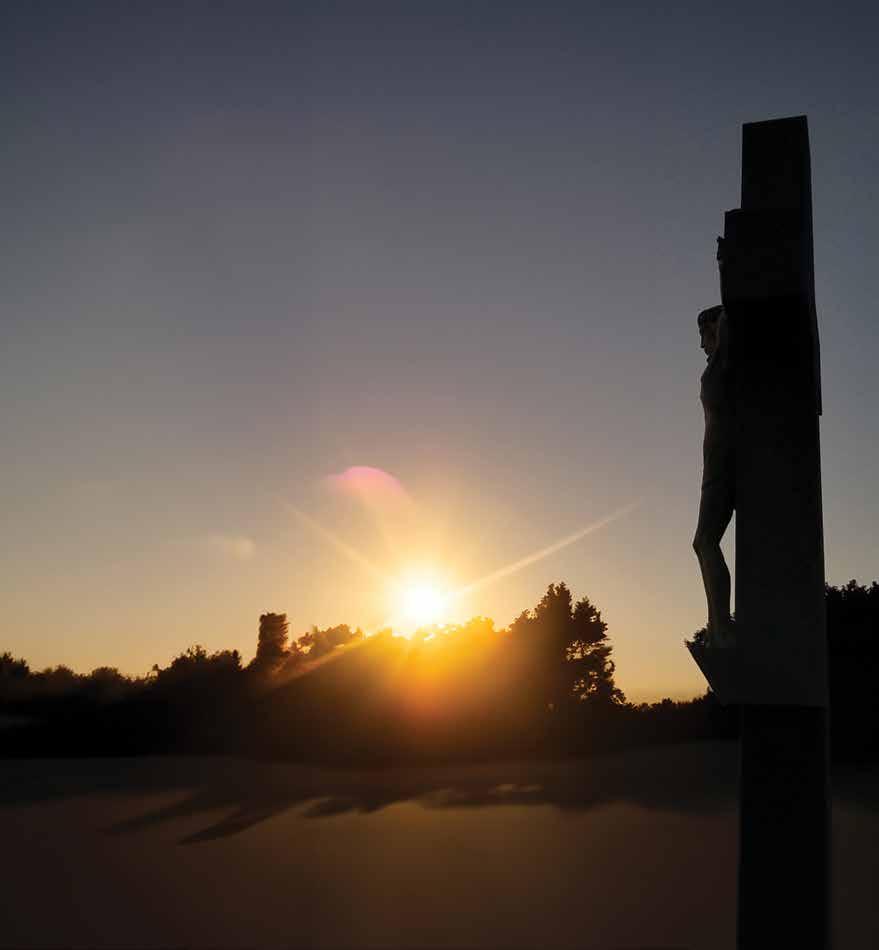

| 37 WE HOPE in the Lord WE TRUST that in Christ all will be One WE PREPARE now for our New Life in Christ Preparing for New Life in Christ “Lord, for your faithful life is changed, not ended.” Roman Missal: Preface I for the Dead 513-489-0300 • gateofheaven.org 11000 Montgomery Rd. • Cincinnati, OH 45249 Follow us on YouTube, LinkedIn, and Facebook! Preplanning one’s final arrangement is a gift to your family when the inevitable happens. Register to attend a complimentary seminar on Tues., March 26, at one of three convenient times: 11 a.m., 2 p.m., or 6 p.m. RSVP and call 513-489-0300 or email community@gateofheaven.org COMING SUMMER OF 2024 Open House Art Exhibit - Gate of Heaven Administration Office The Completion of Gate of Heaven New Mausoleum Complex



9 FACTS ON SAINT BENEDICT
1. Benedict was born at Norcia around 480 AD.
2. He was a twin to his sister, St. Scholastica.
3. When he was a teenager, Benedict performed his first miracle: restoring a broken wheat sifter to perfect condition.
4. His miracle attracted an overwhelming amount of attention, making him retreat to a cave where he lived as a hermit for three years. A neighboring monk gave Benedict a monk’s habit and brought him food each day.
5. Benedict became friends with many shepherds and scholars. They began following his teachings, which were the beginnings of the Benedictine Order.
6. Benedict survived two assassination attempts. Initially, monks who chose him as their abbot grew discontent with his strict rules and attempted to poison him with wine. However, the chalice shattered when Benedict blessed it. In another incident, a jealous priest tried to poison St. Benedict with bread. Knowing the danger, St. Benedict gave the poisoned bread to a raven, a frequent visitor, to carry it away and prevent anyone from eating it.


8. Benedict died on March 21, 547 AD— standing up! He foresaw his death which made his disciples prepare a grave for him to share with his already deceased sister, Scholastica. He received Holy Communion one last time, and while his hands were raised to the Heavens, he passed away.

7. He founded 13 monasteries, including the Abbey of Montecassino, the most famous abbey in Europe.
9. A key motto of Benedictine tradition is “Ora et labora,” which translates to “Pray and work.”




Word Bank
Abbey
Benedict Cave
Hermit
Miracles
Monastery
Norcia
Pray
Prophecy
Scholastica
Spirituality
Teachings
Work

Say this daily prayer through the intercession of St. Benedict.
Dear God,
Help us to love others better. May we be always welcoming and supportive to others. Help us to be close to You when we pray, do our school work and help with chores at home. Guide us to be like St. Benedict and open our hearts to what You want us to do in this life. Please help us to see your light in others and to practice kindness.
Amen.
| 39 KIDS’ CORNER / MARCH 2024


in the Archdiocese out & about

New College Credit Program at SUA
The Carl H. Lindner College of Business and Saint Ursula Academy (SUA) have formed a new initiative to supply SUA students with college-level coursework in entrepreneurship and the opportunity to earn College Credit Plus (CCP) credits. The RDI Entrepreneurship Program will be offered to SUA juniors and seniors in fall 2024 and the program will feature Essentials of Entrepreneurship, a CCP course taught by a Lindner faculty member on-site at SUA.
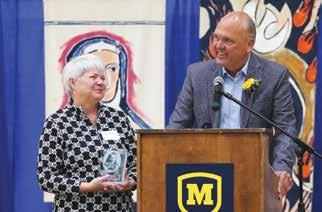
Moeller High School welcomed this year’s Founder’s Day honorees and their families, who were recognized after a special Mass on January 22, 2024. Curt and Linda Curran were recognized for their leadership and service to Moeller. Paul Ramstetter was recognized for his infinite generosity and his modeling of Marianist hospitality.


2) Dayton Catholic Schools Week Mass
Students from Catholic schools across the Dayton area gathered on January 31 at St. Charles Borromeo Church in Kettering to participate in a Catholic Schools Week Mass, celebrated by Archbishop Dennis M. Schnurr.
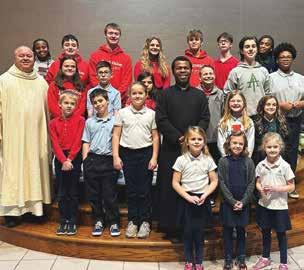
4)
Gift to Transform Mercy McAuley
Mercy McAuley High School received a $1.1 million gift—the largest in school history. In the form of a bequest made by a long-time supporter of Mother of Mercy and Mercy McAuley High Schools, the gift kicks off the school’s transformational capital campaign designed to fund campus improvements and enhancements to faith and academic programs.

40 |
1)
3) Moeller’s Founder’s Day Honorees
4
THE CATHOLIC TELEGRAPH
1
3 2

Catholic Crossword





1
is the fruit of your ___”
5 Number of days from Easter to Pentecost
10 Crustacean
14 Wading bird
15 Lend ___
16 In this place
17 US government disaster agency
18 Former Russian rulers
19 Anger
20 “His ___ is on the Sparrow”
21 Hairy Addams cousin
22 Magician who wanted to buy the gift of God’s power in Acts
23 Not Gomorrah
26 Knocks on the head
28 Gaslight, for one
29 Rudimentary component
33 Deride
35 Water holes
37 Avian migration form
38 Collars
39 Snakelike fish
40 Type of trombone mute
41 Golfer’s aid
42 Burlap
44 Bits of thread
45 Gaunt
47 It precedes Eph
48 The ___ Family
49 Young hooter
52 Zechariah was the first person in the New Testament to see this
55 OT prophetic book
57 Biennial games org.
59 Thick fabric
60 Of sedate character
62 Home of the Taj Mahal
63 Defeat decisively
64 Multitude
65 Storage place (abbr.)
66 Hep
67 Of Nordic stock
68 English public school
DOWN
1 Priscilla, to Aquila
2 Follows orders
3 Xerox predecessor
4 Young men’s org.
5 Our Lady of ___
6 Learning ctr.
7 Noteworthy achievement
8 Complete a street
9 Jr. and sr.
10 Perfumed oil, consecrated by the bishop
11 500 sheets
12 Jason’s ship
13 Part of verb “to be”
22 Gaudium et ___
24 They have coming
out parties
25 Smelter input
26 Fish part for Jonah
27 ___ Saints’ Day
30 Designer Piccone
31 U.S. Speaker of the House and convert to Catholicism
32 Pekoe
33 Greek goddess of the earth
34 “___ your pardon”
35 Sister ___, hermit, consecrated virgin and art historian
36 Even (poet.)
38 Utmost
40 Free ___
42 London jail
43 E-mail datum, perhaps
44 Ezra read this to the people (with “The”)
46 Impoverished neighborhood
47 ___ calf
50 Number of humans in Noah’s ark
51 Trunk of the human body
52 Hairstyle
53 Night light
54 Sate
55 The Blessed Mother
56 Verdi opera
58 City in Northwest France
60 ___ Na Na
61 Rocky pinnacle
62 Fear of the Lord


GERRY KELLY FRITSCH
Traditional Irish Bagpiper gfritsch48@zoomtown.com cincinnatipiper.com 513.404.0049


Subscriptions for the faithful of the Archdiocese of Cincinnati are FREE!
To subscribe, visit our website, or call The Catholic Telegraph offices at 513-263-6635.
| 41 MARCH 2024 FUNERAL SERVICES in the Archdiocese of Cincinnati NAEGELE KLEB & IHLENDORF FUNERAL HOME 3900 Montgomery Rd. | 513.631.2240 Serving Norwood, St. Bernard & surrounding communities 513.385.0511 White Oak / Monfort Heights 5527 Cheviot Rd. Blue Ash / Evendale / Sharonville 10211 Plainfield Rd. 3183 Linwood Avenue • Mt. Lookout Square Serving Eastern Hills, Mt. Lookout & Hyde Park 321-0404 Four generationsoffamilyservice to Eastern Cincinnati. George H. 1910 John H. 1920 J.H.(Don) 1948 Steve 1975 Since 1910 rohdefuneral.com • 513.321.0404 3183 Linwood Ave. | Mt. Lookout Square Directors: Steve Rohde, Denise Mercier, Darrell Schneider Four generations of family service to Eastern Cincinnati 2050 Beechmont Ave. | 513.231.7150 Family-owned & operated since 1870 T.P. White & Sons Funeral Home 2050 Beechmont Ave • 513-231-7150 Mt Washington/Anderson Twp Family owned & operated since 1870 8350 Cornell Road • Cincinnati (Across from Gate of Heaven Cemetery) info@weilkahnfuneralhome.com 513-469-9345 Family-owned & operated since 1912 A Catholic Family Owned Funeral Home –Since 1877 513-891-8373 A Catholic familyowned funeral home since 1877 513.891.8373
1 2 3 4 5 6 7 8 9 10 11 12 13 14 15 16 17 18 19 20 21 22 23 24 25 26 27 28 29 30 31 32 33 34 35 36 37 38 39 40 41 42 43 44 45 46 47 48 49 50 51 52 53 54 55 56 57 58 59 60 61 62 63 64 65 66 67 68 com wordgamesforcatholics www
ACROSS
“Blessed
W O M B F I F T Y C R A B I B I S A N E A R H E R E F E M A T S A R S R A G E E Y E I T T S I M O N S O D O M B A P S E R A E L E M E N T G I B E W E L L S V E E N A B S E E L W A W A T E E G U N N Y L I N T H A G G A R D G A L H O L Y O W L E T A N G E L M A L I O C F E L T S T A I D A G R A R O U T H O R D E W H S E O N T O A R Y A N E T O N moc scilohtacrofsemagdrow www
of
the Truth
Celebrating 23 Years
Broadcasting
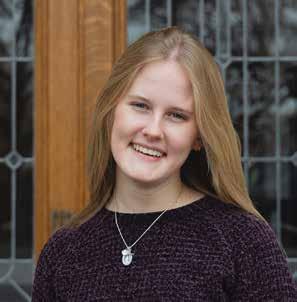
God is good. God is real. God is not boring. He is worthy of our praise and our worship. But what is worship? As the Oxford Dictionary says, worship is “the feeling or expression of reverence and adoration for a deity.” As a cradle Catholic, I could give a similar definition when asked.
From attending a non-denominational Christian middle school, I know worship has different styles, varying by person and denomination. During chapel on Wednesdays, students both led and participated in charismatic worship. While the Catholic Church emphasizes Mass and Liturgy, many Protestant churches focus on worship through praise and song. To me, there was a clear contrast between incense-infused Mass and the Protestants’ more modern style of church.
However, until I attended a summer retreat at Damascus Catholic Mission Campus in Columbus before my sophomore year of high school, the true meaning of worship—to give glory to the one true God—didn’t truly click for me. It became “heart knowledge” rather than a concept in my head. At Damascus, both Mass and worship through music and adoration effectively partnered to show faith’s authenticity and that it is alive through the Holy Spirit. This was a transformational experience for me, as I realized the truth of God and encountered Him in a new way.
Heading home from the retreat, I was determined to create an environment of encounter for those around me to know God and the Catholic faith in a different way. It seemed logical to create an experience similar to mine on the Damascus retreat. So, my best friend and I planned a unique Holy Hour at our parish that featured a reflective talk and used our love for music to worship the Lord through praise and traditional adoration.
As our planned date rolled around, both my excitement and nervousness grew, but I remained eager to spread the Gospel
Worship Through Adoration & Music
in a new way for our Family of Parishes. My friend and I carefully tuned our instruments and filled the church with candles while parishioners gathered. When the monstrance was reverently carried into the chapel, and we strummed the first few guitar chords, my nerves melted away as I realized that even if I messed up a note or sang the wrong words, it was still worship and pleasing to the Lord.
I learned much about true worship that night. First, to maintain faith, action is required. Our Catholic faith is set in a rich tradition of faith and works. Being on mission is required to truly live like Christ, and it can take the form of using our specific gifts or simply stepping into intentionality with words and actions.
Second, I learned that using our talents is a beautiful way to praise God and that showing others the ministry-invested side of myself is valuable. I also witnessed these Holy Hours’ impact on my friends’ faith, as some encountered the Lord in a new way. They have come to know that religion is not simply a set of rules, but rather a foundation to grow in a relationship with a personal God. Their definition of worship evolved from simply checking boxes to actually taking a deep dive into this relationship.
So, what is worship? Worship is unveiling and living out the Church’s complexities and mission through our unique talents, but it is also bringing others into awareness of Heaven’s glory and the Gospel’s beauty. Worship is giving God what He is due and living out what we were made for.
BELLE GRUBERT
is a soon-to-be high school graduate living in Cincinnati. She will enter university in the fall of 2024 and study business and psychology. She loves peonies, high-top converse and playing music and is committed to being actively involved in her Catholic faith and in ministry.
42 | THE CATHOLIC TELEGRAPH
THE FINAL WORD with Belle Grubert



128

Courage
192



Jesus,
192


160

The
160


Welcoming
160 pages, $15.95

Start
JULIA SANDUSKY
256 pages, $19.95
more
READS FOR SPRING
Look for these titles wherever books and eBooks are sold. For
information, visit avemariapress.com. CATHOLIC
Behold, Believe, Become TIMOTHY P. O’MALLEY
pages, $13.95 AVAILABLE IN ENGLISH AND SPANISH!
to Create CLARE MCCALLAN
pages, $16.95
Make Me Fully Alive
FR. TIM ANASTOS
pages, $17.95
A Saint Squad for Teachers
AMY J. CATTAPAN
pages, $16.95
Reaching for Heaven MICHAEL AMODEI
pages, $16.95
Family That Prays Together Stays Together
FR. PATRICK PEYTON, CSC EDITED BY FR. WILLY RAYMOND, CSC
144 pages, $12.95
the Holy Spirit with Padre Pio SUSAN DE BARTOLI
Talking with Your Teen about Sex




100 E. 8th St. • Cincinnati, OH 45202

















 BY RACHEL WEIDNER
BY RACHEL WEIDNER















 BY JOHN STEGEMAN
BY JOHN STEGEMAN












































 BY FATHER JOHN LANGLOIS, OP
BY FATHER JOHN LANGLOIS, OP




 BY CYNTHIA MONTANARO
BY CYNTHIA MONTANARO









 BY FATHER JACOB BODDICKER, SJ
BY FATHER JACOB BODDICKER, SJ
 BY MATT HESS
BY MATT HESS






























































